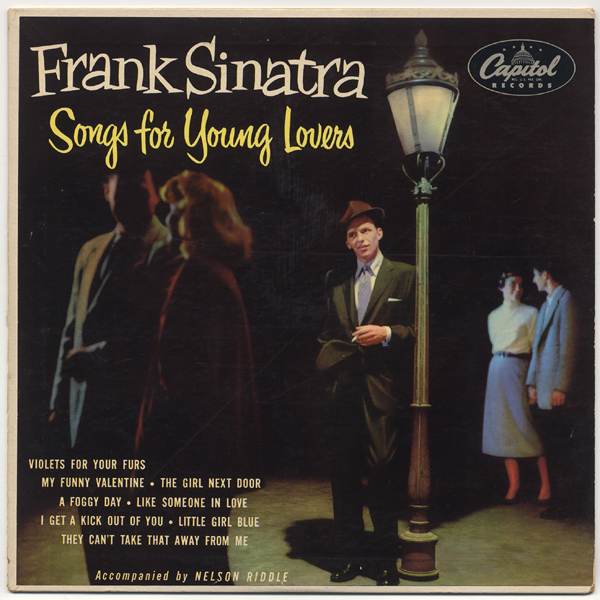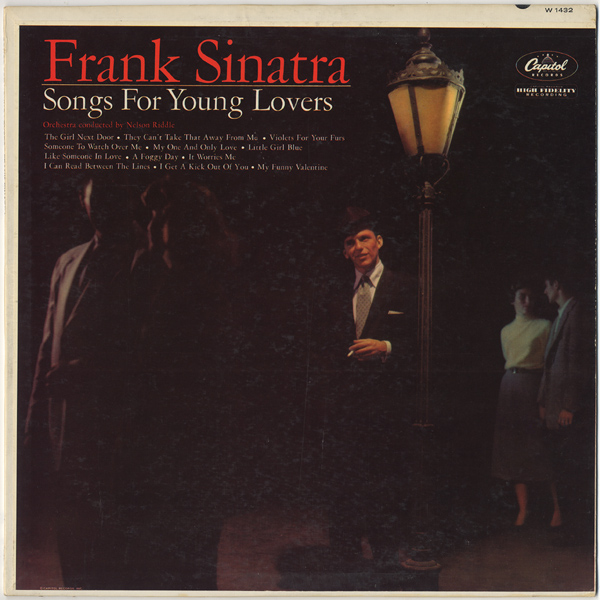EQカーブの歴史、ディスク録音の歴史を(私が独りで勝手に)学ぶ本シリーズ。前回 Pt.23 では、1970年代民生用アンプに内蔵されたフォノイコの RIAA 偏差 に関する興味深い記事、および、米国で伝統的に使われていた LCR 録音イコライザの話などを紹介しました。
In the previous Part 23, I learned an interesting article on RIAA deviation of 1970’s consumer amplifiers, as well as LCR recording/reproducing equalziers that had been the legacy especially in the United States.
今回の Pt.24 では、音声信号が最終的にレコードの溝として記録されるまでに通過するシグナルチェーン、そこで使われる機器の歴史的変遷などについて、改めて復習していきます。
This time on Pt.24, I am going to revisit and learn the signal chain from the audio source to the groove cut into lacquer discs, as well as the history and evolution of these.

source: RCA Engineer, Vol. 3, No. 2, Oct.-Nov. 1957, pp.8-9
1957年のRCA社内エンジニア向け紀要に掲載された、録音プロセスのフローチャート
“Recording process flow chart” from 1957 technocal bulletin for RCA’s engineers.
毎回書いている通り、筆者自身の学習過程を記したものですので、間違いの指摘や異論は遠慮なくお寄せください。
As I noted in every part of my article, this is a series of the footsteps of my own learning process, so please let me know if you find any mistakes on my article(s) / if you have different opinions.
いつものように長くなってしまいましたので、さきに要約を掲載します。同じ内容は最後の まとめ にも掲載しています。
Again, this article become very lengthy — so here is the summary of this article beforehand (the same summary are avilable also in the the summary subsection).
ディスク録音再生EQカーブだけが、周波数応答特性を決定するものではない。録音時、ミキシング時、マスタリング時、カッティング時、再生時、それぞれの段階で、意図的に音にEQがかけられていたり、さまざまな音の変化が起こりうる。極論すれば、リスナーの聴覚や感性ですら受け取り方に差をもたらすと言える。
The disc recording and playback EQ curves are not the only factor that determine frequency response characteristics. Various sound changes can occur (or intentionally EQ’d) at each stage of recording, mixing, mastering, cutting, and even playback. In an extreme case, even the listener’s hearing and sensivity can make a difference in how the sound is perceived.
特にポピュラー音楽の分野では、スタジオによって、エンジニアによって、時代のトレンドによって、イコライザやコンプレッサ、リヴァーブなどさまざまな機器で音作りをすることが一般的である。そのような要因をあまり含まないクラシック音楽のレコードであればさておき、主観的な試聴判断で単純にフォノEQカーブだけの議論に落とし込むのは、特に米国のステレオLP以降に対しては、理にかなっていない。
Especially in the field of popular music, it has been common for different studios, different engineers, and different trends of the times to create sounds with various equipment such as program equalizers, compressors, reverbs, and so on. Aside from classical records that do not include many such factors, it is not reasonable to simplify the discussion to the selection of phono EQ curves, based on subjective listening judgements, especially for the U.S. stereo LPs.
当時制作されたLP用マスターテープからリイシューされた音源、マルチトラックマスターテープにまでさかのぼってリミックスされた音源、当時のシングル用マスターテープからリイシューされた音源などを聴き比べることで、ディスクカッティング直前の段階でさまざまな音作りがされていることが確認できる。
By comparing sound sources reissued from LP master tapes produced at the time, re-mixed sound sources that go back to multi-track master tapes, and sound sources reissued from single master tapes produced at the time, it is possible to confirm that various sound production processes were conducted at the stage just before disc cutting.
Contents / 目次
- 24.1 Reviewing the audio signal paths in disc recording systems
- 24.1.1 Microphones
- 24.1.2 Microphone Placement and Room Acoustics
- 24.1.3 Microphone Preamps
- 24.1.4 Mixing Consoles
- 24.1.5 Reel-to-Reel Tape Recording/Reproducing Equalizers
- 24.1.6 Program Equalizers
- 24.1.7 Hi-Pass/Low-Pass Filters / Limiters / Compressors / De-Essers / LFX
- 24.1.8 Echo Chambers and Reverberation Machines
- 24.1.9 Disc Recording Equalizers
- 24.1.10 Automatic Diameter Equalizers
- 24.1.11 Cutterheads and associated Equalizers
- 24.1.12 Pressing at Plants
- 24.1.13 Reproducing with Home Equipment, with Human Auditory
- 24.2 Recording/Reproducing EQ is NOT the only factor to define overall sound characteristics
- 24.3 Some examples of different masterings heard on CDs
- 24.4 The summary of what I got this time / 自分なりのまとめ
24.1 Reviewing the audio signal paths in disc recording systems
この一連の記事(という名の調査学習履歴)は、もともとは ディスクレコードにおける録音再生特性の歴史 に焦点をあてたものですが、言うまでもなく、再生音の周波数応答特性や位相特性に影響する要因はそれ以外にも多数あります。
This series of articles (a.k.a. my research study history) originally has focused on the history of recording and reproducing characteristics in disc records. However, needless to say, there are many other factors that affect the frequency response and phase characteristics of the reproduced sound.
スタジオやコンサート会場で生音が捉えられてから、周波数特性や位相特性などに影響しうるさまざまな信号経路を通過し、さまざまな編集やマスタリングが施された上で、レコードの音溝として刻まれることでメディアに閉じ込められ、それぞれの機器や環境で再生されるのですから。
This can be understood like this: after the live sound is captured in a studio, concert hall or field, it passes through various signal paths that can affect its frequency response and phase characteristics; it is edited and mastered in various ways; it is then engraved as a sound groove on a record (lacquer), thereby being confined to the media and played back with each equipment in each environment.
そこで、本セクションでは、いままでの復習を兼ねつつ、ディスクレコード用電気録音のシグナルチェーン(信号経路)において、時代を追うごとにどのような機器が開発され使用されてきたかをみていきます。
So in this section, we are going to review the development and use of different types of equipment in the signal chain of electrical disc recording over the ages.
【お断り】私自身はプロの録音エンジニアでもプロの音響技術史研究者でもありません。よって当然ながら、以下に記すことに間違いがあるかもしれません。もしなにか勘違いや誤解がありましたら、遠慮なくご指摘ください。
[Disclaimer] I myself am neither a professional recording engineer, nor a professional sound technology historian. Therefore, there may be mistakes and misunderstandings in what I have written below. If you find any misunderstandings or misconceptions, please do no hesitate to point them out to me.
24.1.1 Microphones
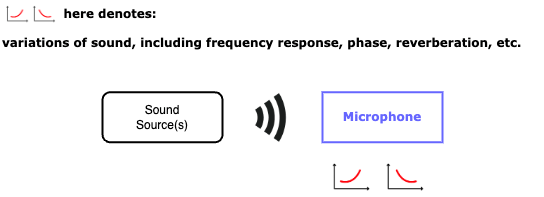
電気録音ではまず、捉えられた生音(空気振動)を電気信号に変換するトランスデューサが必要となります。マイクロフォン です。
Electrical recording first requires a transducer that converts the captured raw sound (air vibrations) into an electrical signal — known as a microphone.
マイクには大別すると、ダイナミック型、コンデンサ型、リボン型、クリスタル型、カーボン型などがあり、技術の進化に応じてさまざまな機種が生まれてきました。
Microphones can be broadly classified into such types as dynamic, condenser, ribbon, crystal, carbon, etc., and various models have been developed and utilized as technology has evolved.
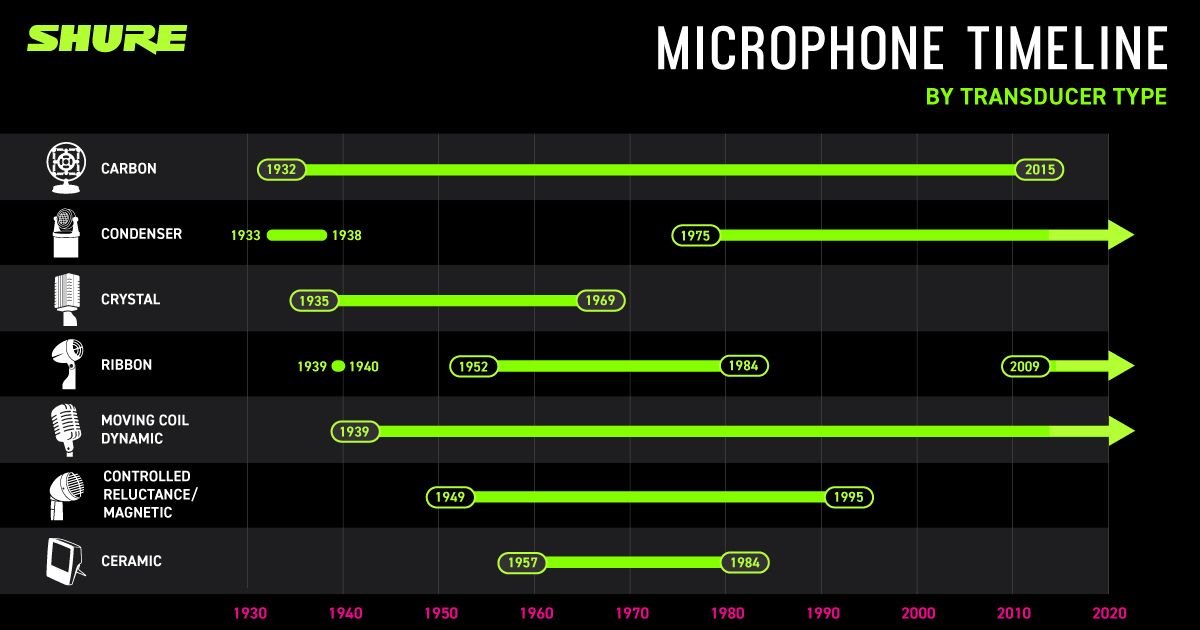
source: “The History of Crystal Microphones and Artifacts from the Shure Archives”
Pt.7 セクション 7.1 で紹介した Shure の年表。
時代に応じてさまざまなトランデューサのマイクを製造販売してきた
マイクの周波数応答特性も、時代や機種によってさまざまです。そして、音楽ジャンルにあわせて、録音スタジオに合わせて、狙った音作りに合わせて、さまざまな特性をもったマイクが使い分けられたりします。
The frequency response characteristics of microphones also vary from era to era, and model to model. Microphones with various characteristics are used according to music genres, recording studios, and the intended sound production.
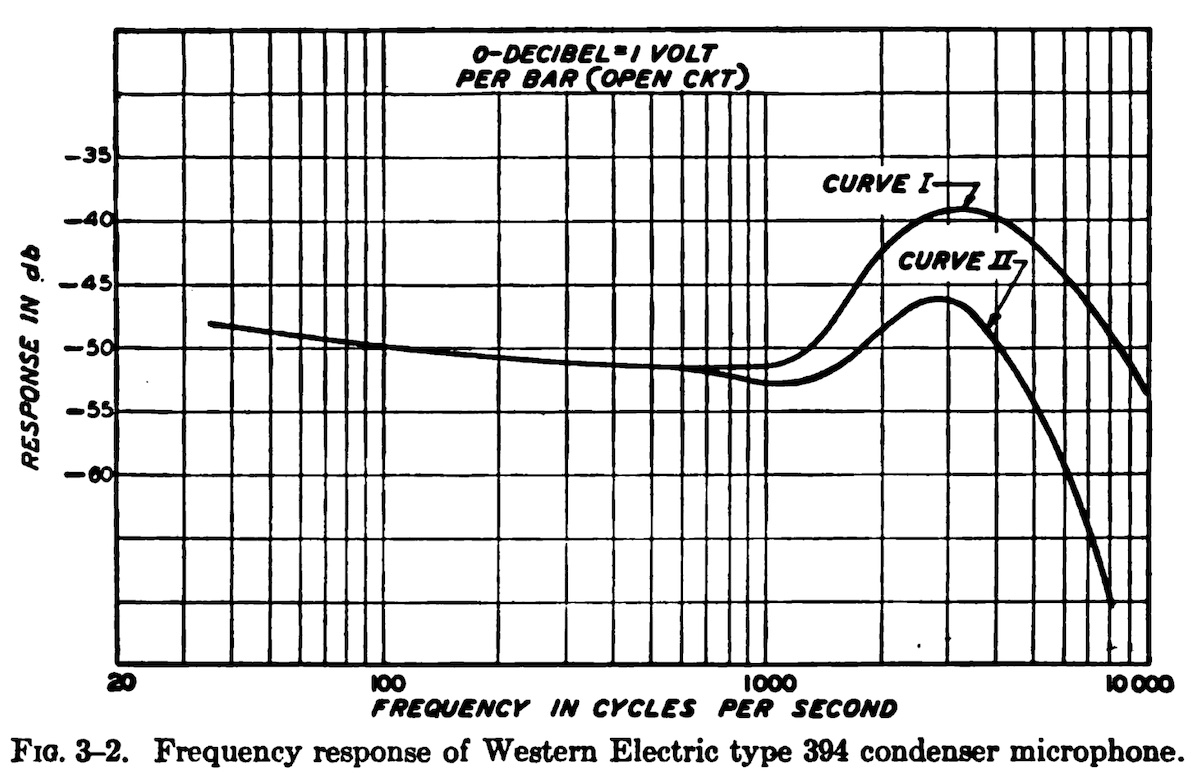
source: “Elements of Sound Recordings”, p. 36, by John G. Frayne and Halley Wolfe, 1949.
Western Electric 394 コンデンサマイクの周波数特性グラフ。3.5kHz に +10dB 以上のピークがみられる
電気録音黎明期のコンデンサマイクの中域レゾナンスピークが、のちのディスク録音イコライザにおける高域プリエンファシスの萌芽となった可能性がある、という話題は 本稿 Pt.3 セクション 3.4.5 で触れました。
Pt.3 Section 3.4.5 already mentions that the midrange resonance peak of condenser microphones in th early days of electrical recoding might have been the germ of the high-frequency pre-emphasis in later disc recording equalization.
そして、時代が進み、リボンマイク、次いでダイナミックマイクが普及する過程で、よりフラットな周波数応答特性を持つマイクも一般的となっていきました。
Then as time went on and ribbon microphones, followed by dynamic microphones, became popular, microphones with flatter frequency response characteristics also became common.

source: “RCA Broaccast Equipment Catalog”, p.8, RCA Victor, 1939.
1939年RCA Victorの放送機器カタログに掲載された、44-BX の周波数特性グラフ
一方で、現在でも「プレゼンスピークを持つ」「プレゼンスブーストが施された」すなわち中高域が意図的に増幅された特性を持つマイクや、低域をロールオフした特性のマイクなど、さまざまな特性のマイクがあり、スネアドラム用、ヴォーカル用、など収録目的によって使い分けられています。
On the other hand, even today, there are microphones with various characteristics, such as microphones with “presence-peaked” or “presence-boosted”, i.e., microphones with mid-high frequencies intentionally amplified, and microphones with low-frequency roll-off characteristics, which are used for different purposes, such as for snare drums, vocals, etc.
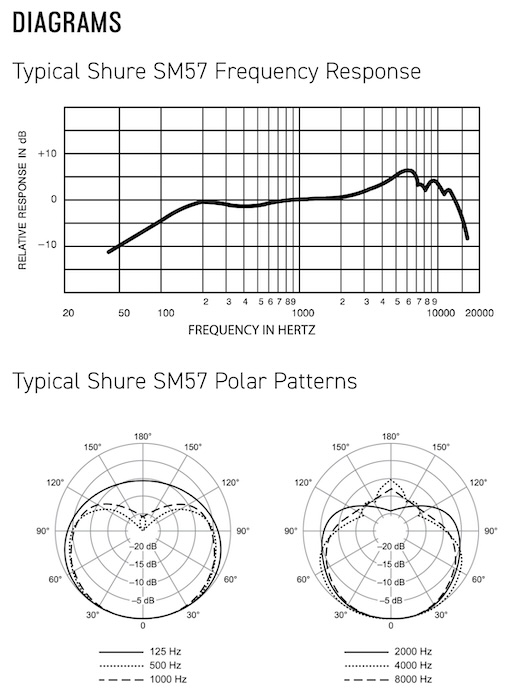
source: Shure SM57 Instrument Microphone Manual.
特にスネアドラム用マイクとして重宝される Shure SM57 の周波数応答特性
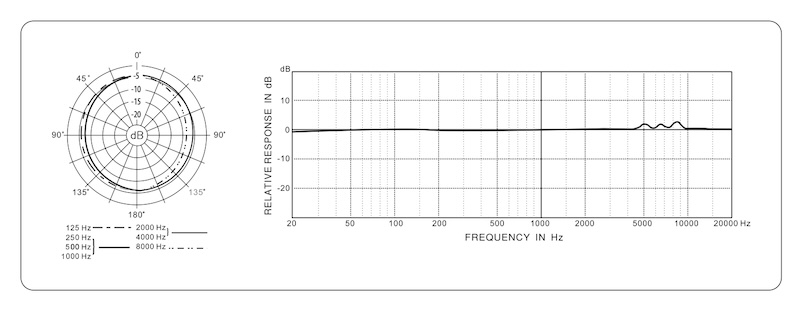
source: “Behringer Measurement Condenser Microphone ECM8000 Technical Specifications”.
高コスパで有名な音響測定用マイク Behringer ECM8000 のほぼフラットな周波数応答特性
さらには、マイクの 指向特性(無指向性、単一指向性、双指向性)も、マイク設置位置やルームアコースティクスとの組み合わせで捉える音の特性に大きく影響します。
Furthremore, the directional characteristics of the microphone (omni-directional, uni-directional, or bi-directional) also have a significant effect on the characteristics of the sound captured when combined with the microphone placement position and room acoustics.
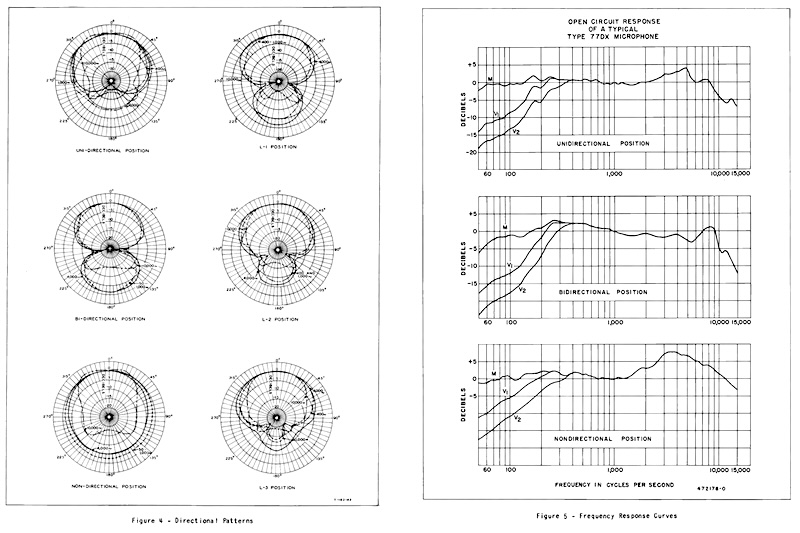
source: RCA Type 77-DX Polydirectional Microphone Instructions.
単一指向性/無指向性/双指向性を切り替え可能な RCA 77-DX の応答特性
24.1.2 Microphone Placement and Room Acoustics
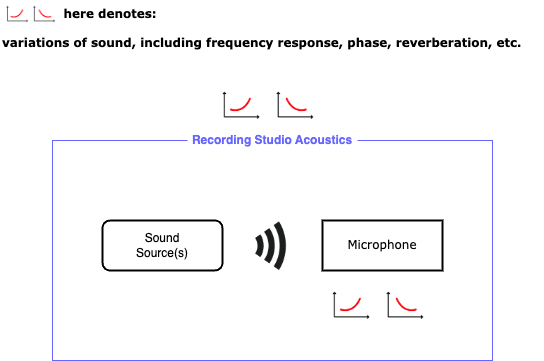
マイクと音源との距離、すなわち マイクの設置位置 によっても、応答特性が大きく変わります。これは「近接効果」(Proximity Effect)として知られるもので、音源により近接した位置にマイクを設置すると、低域が強調される現象です。上述の低域をロールオフした特性のマイクは、この近接効果を補正する目的もあります。
The distance between the microphone and the sound source, or the location of the microphone, also greatly affects the response characteristics. This is known as the “Proximity Effect”, the enhancement of low frequencies when the microphone is placed closer to the sound source. The microphones with low-frequency roll-off characteristics described above are also intended to compensate for this proximity effect.
そして、録音スタジオの ルームアコースティクス も、マイクが拾う音の特性に大きく影響するのは言うまでもありません。
It goes without saying that the room acoustics of the recording studios also greatly affect the characteristics of the sound picked up by the microphones.
また、上述した マイクの指向特性(無指向性、単一指向性、双指向性)も、マイク設置位置やルームアコースティクスとの組み合わせにより、捉えられる音の特性に大きく影響します。
The directional characteristics of microphones (omni-directional, uni-directional, and bi-directional) mentioned above also greatly affect the characteristics of the captured sound, depending on the location of the microphone and its combination with room acoustics.
24.1.3 Microphone Preamps
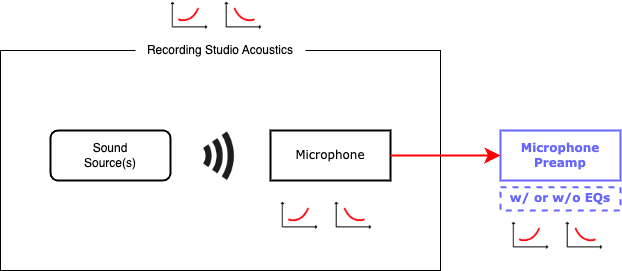
マイクの出力を適切に増幅し、またインピーダンスを後段のシグナルチェーンに合わせる役割を果たすのが、マイクプリアンプ です。
Microphone preamplifiers are responsible for properly amplifying the microphone output and matching its impedance to the signal chain of the subsequent stage.
特定のマイクと組み合わせる目的で作られた専用マイクプリアンプ、さまざまなマイクと組み合わせる汎用マイクプリアンプ、マイクの中にプリアンプが内蔵されたもの、などいろいろあります。
There are many different types of microphone preamplifiers: dedicated microphone preamps designed for use with specific microphones; general-purpose microphone preamps for use with a variety of microphones; or preamps built into microphones.
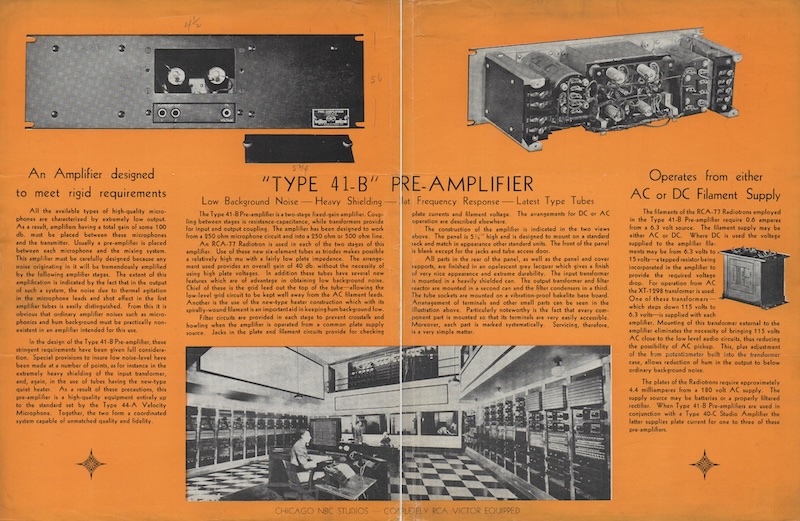
source: RCA 41-B Brochure (at World Radio History).
1933年製 RCA Victor 41-B マイクプリアンプのパンフレット
46-A ミキサーパネルや 40-C パワーアンプと組み合わせることを想定
例えば、以下のサイトでは、RCA 4PB31A1 リボンマイクと組み合わせる、専用のマイクプリアンプ、RCA 4PA72A1 の実物写真を見ることができます。
For example, at the following webpage you can see actual photos of the RCA 4PA72A1, a dedicated microphone preamplifier to be used with the RCA 4PB31A1 ribbon microphone.
1931年、RCA Victor 録音システムのマイクがコンデンサマイクからリボンマイクに変更された際、コンデンサマイクにあった中域のレゾナンスピークが、当時としてはフラット特性なリボンマイクではなくなってしまったため、コンデンサマイクのプリアンプにレゾナンスピークを再現するイコライジング回路「Voice Effort Equalization」を追加した、という話を 本稿 Pt. 3 セクション 3.4 で紹介しました。
I already described in the Pt. 3 Section 3.4 that in 1931, when the microphones in the RCA Victor recording system were changed from condenser microphones to ribbon microphones, the midrange resonance peaks in the condenser microphones were no longer present in the ribbon microphones (which ad a relatively flat response characteristic at the time), and that RCA Victor added an equalization circuit called “Voice Effort Equalization” to the condenser microphone pre-amplifier to emulate the condenser microphone’s resonance peak.
When we took our new 680 (first dynamic mic) to the studios to demonstrate, no one liked the result because that peak in the middle was not there. They were used to hearing it. We put it in electronically and called it “voice effort equalization”.
(NOTE: “680” (six-eighty) in this interview could be “(Western Electric) 618A” (six-eighteen), that was introduced 8 months before RCA’s 44A)
我々がスタジオに初めてのダイナミックマイク (680) を持ち込んでデモをした際、誰ひとりその結果を好んでくれなかった。コンデンサマイクにあった中高域のピークがなくなっていたからだ。みんなあの音に慣れ親しんでいた。だから “voice effort equalization” という名前で、その中高域のピークを電気的に導入した。
(注: ここでいう “680” (six-eighty) というのは、RCA 44A より8ヶ月前にデビューした “(Western Electric) 618A” (six-eighteen) のことかもしれません)
また、RCA はその「マイクプリアンプの中高域増幅回路を」1938年に撤廃、シグナルチェーンの後ろに持っていくことで、録音カーブの一部として独立させたことが、R.C. Moyer 氏のかの有名な解説記事「Evolution of a Recording Curve」(Audio Engineering, July 1953)で紹介されています。
Also, RCA eliminated its “microphone preamplifier mid-high frequency amplification circuit” in 1938 and made it an independent part of the recording curve by bringing it to the back of the signal chain, as described in R.C. Moyer’s famous article “Evolution of a Recording Curve” (Audio Engineering, July 1953).
後年になると、イコライザが内蔵されたマイクプリアンプも多く登場しました。マイク内蔵プリアンプのイコライザ回路によって、マイクそのものの特性と相まって、音作りを行います。
In later years, many microphone preamplifiers with built-in equalizers also became common. The equalizer circuitry of the built-in microphone preamplifier creates the sound, coupled with the characteristics of the microphone itself.

Behlinger MIC2200 V2 Microphone Preamplifier
ハイパスフィルタとパラメトリックイコライザを内蔵したマイクプリアンプの例
24.1.4 Mixing Consoles
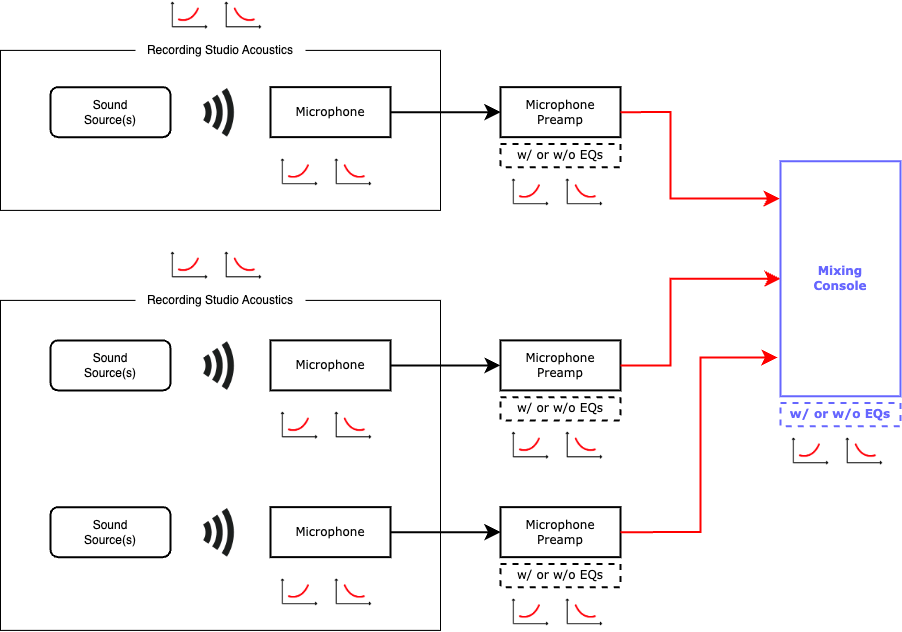
1940年代末までは、ダイレクトカッティングによるディスク録音が主流で、かつモノーラル時代ですから1チャンネルでした。
Until the end of the 1940s, direct-to-disc recordings were the norm, and since it was the monaural era, they were one-channel recordings.
その一方、マイクを複数立てるプラクティスは1930年代の映画/ラジオの全盛期と相まって徐々に発展し、ミキシングコンソール を介して複数入力を最終的な1チャンネルに落としていました。
Meanwhile, the practice of putting up multiple microphones gradually developed in conjunction with the heyday of film/radio in the 1930s, with multiple inputs being mixed into a single final channel via mixing consoles.
当時は、RCA と Western Electric のミキサーしか存在せず、しかもリースでのみスタジオに提供されていたそうです。
At the time, only RCA and Western Electric mixers existed, and they were only available to studios on lease.
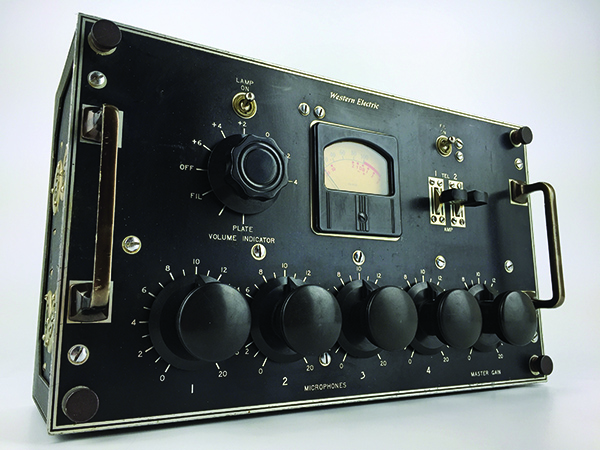
source: “The Way We Were: Mixers Past and Present (Part 1)”, Iatse Local 695.
初期を代表する Western Electric 22C ミキシングコンソール
1940年代まではほぼ全てのスタジオがミキサーを所有しておらず、Western Electirc または RCA からリースしていた
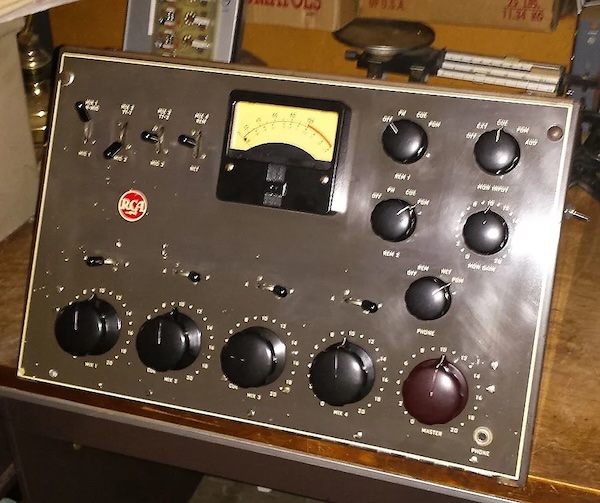
source: Reverb.com
1950年代を代表するミキシングコンソールの1つ、RCA BC-5 シリーズ
4チャンネルマイク入力を1チャンネルモノーラル出力するミキサー
また、録音現場においてオープンリールテープが主流となった1950年代以降、マルチチャンネル化が徐々に進むことで、ますますミキシングコンソールの重要性が増していきました。この頃になると、リースのみではなく、製品として販売されるミキサーも多数登場していました。
In addition, mixing consoles became increasingly important after the 1950s, when reel-to-reel tapes became the mainstream in the recording field, and the gradual shift to multi-channel mixing became more and more important. By this time, many mixers were being sold as products rather than only leased.
1960年代の伝説的な Universal Audio UA 610 コンソール
時代がさらに進むと、チャンネル数はますます増え、またフェーダのほかフィルタやイコライザなどがチャンネルごとに装備されるようになり、ミキシング時にチャンネルごとに調整可能となりました。
As time went on, more and more channels were required and added, and each channel was equipped with a fader as well as filters and equalizers that could be adjusted for each channel during mixing.
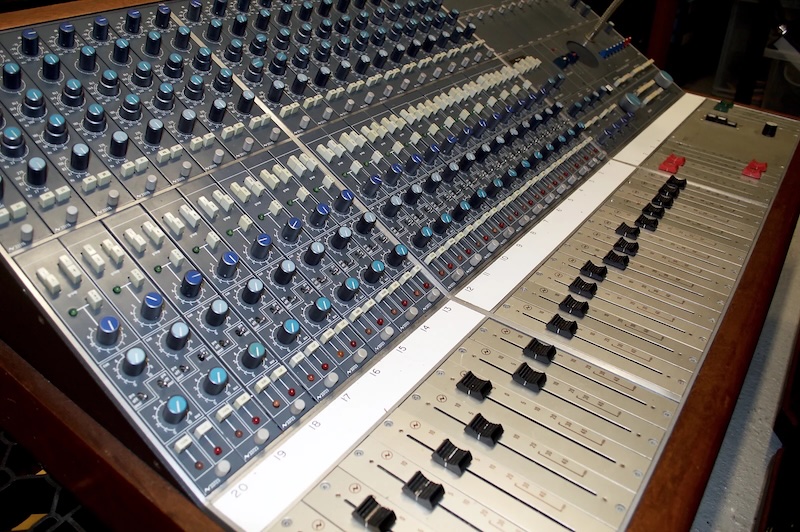
source: Reverb.com
1970年代を代表するミキシングコンソール Neve 5305
ヴィンテージのミキシングコンソールから抜き出された チャンネルストリップ は、その独特の音色で今でも根強い人気があるそうです。
Channel strips extracted from vintage mixing consoles are still very popular and sought-after for their unique sound and tones.
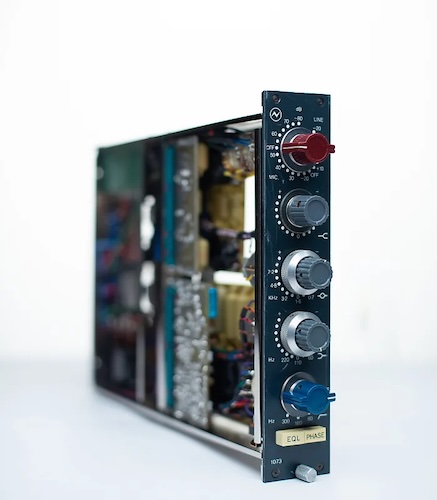
source: Reverb.com.
ミキシングコンソールのチャンネルストリップで有名なヴィンテージ Neve 1073、
マイクプリアンプ + 3バンドEQ + ハイパスフィルタ + フェーズシフタ + … が一体となった製品。
24.1.5 Reel-to-Reel Tape Recording/Reproducing Equalizers
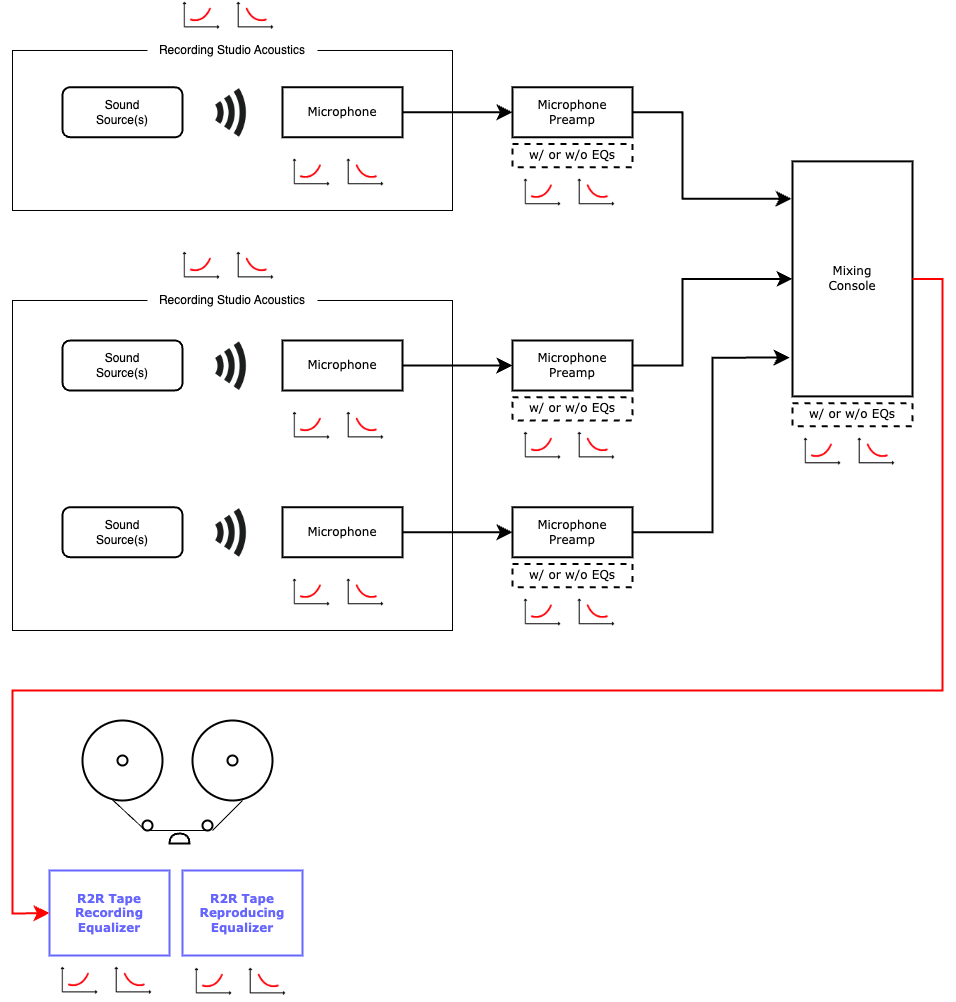
1940年代末に登場時、あっという間に民生用レコード制作現場で必須の機器となった、オープンリールテープ のドメイン(Pt. 17 セクション 17.2 参照)でも、ディスク同様に録音再生特性が存在しました。
In the domain of Reel-to-Reel Tapes, which instantly became essential equipment for consumer record production when it was introduced in the late 1940s (see also: Pt. 17 Section 17.2), the recording and reproducing characteristics existed just like in the disc recording / reproducing domain.
テープにおいても黎明期は複数の録音再生規格がありましたが、民生用レコードの世界と比べると比較的混乱は少なく、テープ速度ごとに CCIR/IEC1 または NAB/IEC2 という規格で統一されました。
In the early days of R2R tapes, there were several standards for recording and reproducing, but compared to the world of consumer disc records, there was relatively little confusion: the standards were unified under CCIR/IEC1 or NAB/IEC2 for each tape speed.

source: “Doing It For Effect… Equalisation”, by Len Lewis, Studio Sound, October 1979, p.50.
ディスク録音再生EQとは異なり、録音EQと再生EQが非対称であることに注目
1トラックモノーラルの時代から、録音したてのマスターテープをそのまま使ってカッティングすることは(クラシック作品などを除くと)稀で、通常はスプライシングなどの編集をしたり、複数のテープからトラックごとにダビングしてカッティング用マスターテープへを作るため、ここでも音に変化が起こることになります。
Since the days of one-track monaural recordings, it had been rare for a freshly recorded master tapes to be directly used for cutting (with the exception of classical works). Usually, splicing and other editings were done, and tracks were dubbed from multiple tapes to create cutting master tapes, which also resulted in changes to the sound.
よって、テープの世界における(意図しない)応答特性の変化は、録音再生規格による周波数応答特性の違いというよりは、アジマス、テープそのものの特性のばらつき、テープ自体の劣化具合、コピーによる鮮度劣化、などの影響をより多く受けていたと考えられます。
Therefore, (unintentional) changes in response characteristics in the tape domain might be the result of the azimuth, variations in the characteristics of each tape itself, the degree of deterioration of the tapes, deterioration of “freshness” due to copying, etc., rather than differences in frequency response characteristics due to the choice of recording and reproducing standards.
とはいえ例外もあって、Contemporary の Roy DuNann 氏のように、テープ速度 15ips で録音時に敢えて 7.5ips 用の録音カーブ(高域プリエンファシスがより強い)で記録し、カッティング時にデエンファシスすることで独自のノイズリダクションを実践していた、というエピソードは(真偽は不明ながら)よく目にします。
However, there are some exceptions to this rule, including the famous episode of Roy DuNann of Contemporary Records (although the authenticity is unknown). According to the episode, Mr. DuNann recorded at 15 ips tape speed with the recording curve for 7.5 ips (with stronger high-frequency pre-emphasis), and de-emphasized it during cutting, in order to achieve his own unique noise reduction.
Another step that Roy took during mastering was to roll back the 6dB high-frequency wide-curve boost that he had tweaked into the Ampex during recording. Long before Dolby, Roy was figuring out his own methods for reducing tape hiss.
マスタリング時に Roy 氏が行ったもう1つのステップは、レコーディング時に Ampex テープレコーダに仕込んだ 6dB 高域ブーストをロールバックすることだった。Dolby NR が誕生するよりずっと前から、Roy 氏はテープ・ヒスを減らす独自の方法を見つけ出していた。
The Search for Roy DuNann, Steven Cerra, JazzProfiles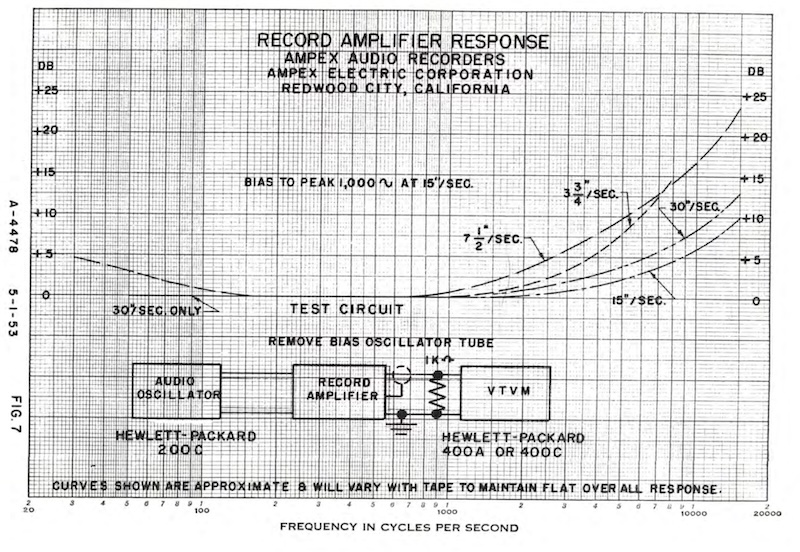
source: Ampex 350 Manual (at Steam Powered Radio).
これに関し、Lester Koenig 氏の息子である John Koenig 氏は「初期の OJC リカットは(マスターからほぼストレートにカッティングしているため)ひどい音がする」と コメントしています が、一方で Steve Hoffman 氏は「Howard Holzer 氏がマスタリングした一部のアルバムを除き、基本的にはマスターテープのままで問題ないし OJC の音も特に問題はない」と述べていることを記しておきます。
John Koenig, son of Lester Koenig (founder of Contemporary Records), commented that “the early OJC recuts sounded terrible (because they were cut almost straight from the masters)”, while Steve Hoffman stated that “except for a few albums mastered by Howard Holzer, there is basically no problem with cutting directly from the master tapes, and no problem with the sounds of the OJC recuts”.
Eh, this is really a non-issue, except in the case of a few titles. I’ve worked on maybe 40 Contemporary recorded titles, most are just fine played back straight.
一部のタイトルを除けば、特に問題はない。Contemporary の作品は過去に40タイトルほど手がけたが、ほとんどはそのまま再生しても問題はない。
Regarding fixing the top end boost, this is something that is done by ear during mastering. Most of the stuff sounds fine straight. Way Out West needs a db out at 10k on the sax channel but that is all. Anything more and it sounds dull and muffled. The only actual Contemporary album that really needed top end reduction was Art Pepper’s Intensity. 3db out at 10 for that one. There may be others, sure, but the really famous titles don’t have that problem for the most part. The trick is to get a saxophone to sound natural. If it does played back flat, it stays that way. If it’s a bit harsh, a db or so of 10k reduction will help. But taking 6 db out at 10k for all Contemporary stuff would just make everything sound dead.
トップエンドのブーストの修正については、マスタリング時に耳で確認して行う。ほとんどの作品はストレートで問題ない。Way Out West は 10kHz で 1dB 下げる必要があるが、それだけだ。それ以上下げると鈍くこもった音になってしまう。Contemporary の作品で本当にトップエンドを下げる必要があったのは、Art Pepper の Intensity だけだ。あれは 10kHz で 3dB 下げる必要があった。他にもあるかもしれないが、本当に有名な作品群においては、ほとんどそのような問題はない。コツは、サックスが自然な音で鳴るようにすることだ。もしフラット再生でそうならば、いじる必要はない。少しきつい音がするようであれば、10kHz で 1dB ほど下げると良くなる。しかし、Contemporary の全作品(のマスターテープ)に対して 10kHz で 6dB 下げると、全ての音が死んでしまう。
Actually, thinking about it, some Contemporary titles (like “Harold In The Land Of Jazz”) engineered by Howard H. have a weird upper midrange boost that is really annoying. They have to be reduced starting around 6k or else the music sounds strident and harsh. Mostly 1957 stuff. After that whatever he was doing, he stopped..
実際、考えてみると、Howard Holzer がエンジニアを務めた Contemporary の作品(“Harold Land in the Land of Jazz” など)の中には、中高域が妙にブーストされているものがあり、実に耳障りだ。6kHz あたりから下げないと、音楽が強張ってキツく聴こえてしまう。これらはほとんどが1957年の作品だ。その後、彼が何をしていたにせよ(この音作りを)やめてしまった。
Contemporary Records jazz titles recorded by Roy DuNann: remastering techniques and challenges (Steve Hoffman Music Forum, 2022)24.1.6 Program Equalizers
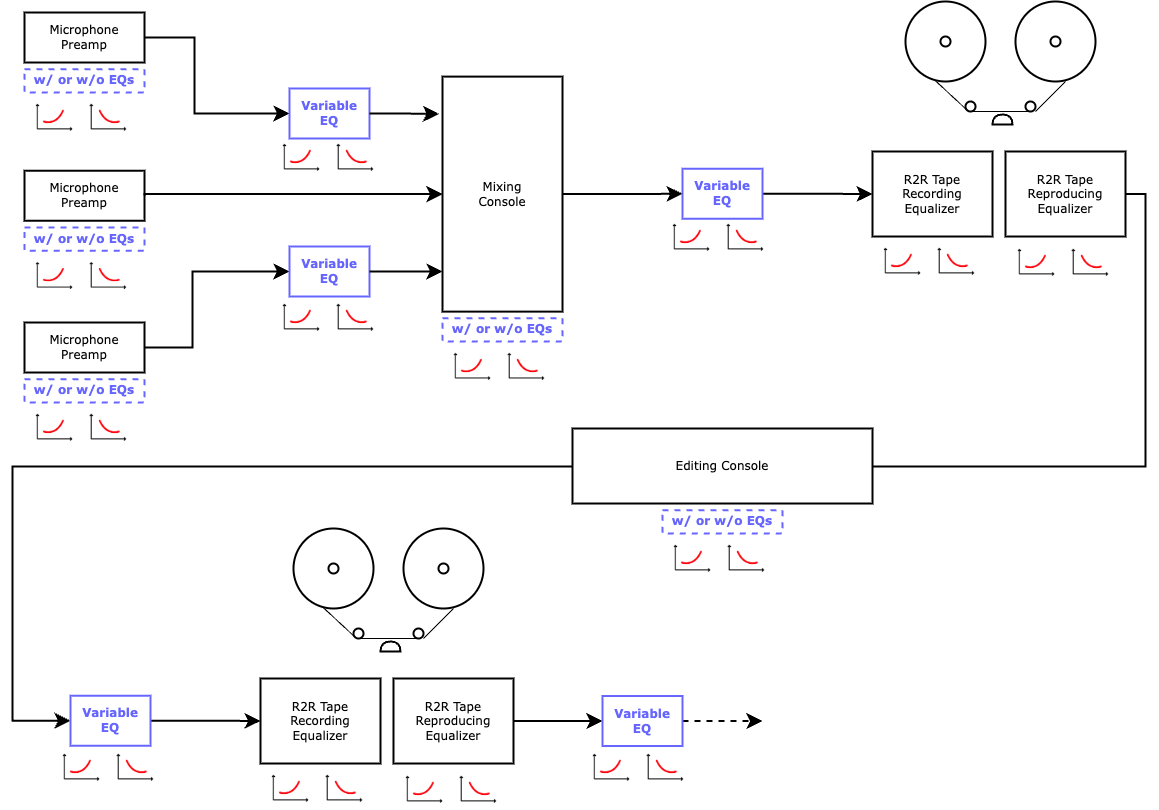
テープの編集時、さらにはカッティング用マスターテープ制作時に、カッティング機材の特性を念頭におきつつ プログラムイコライザ でさらにイコライジングを意図的に施すことが(特にポピュラー系、ジャズ系などでは)多く行われていました。
During tape editing and master tape production for cutting, it was often the case (especially for popular and jazz music) that further equalization was intentionally applied using program equalizers while keeping in mind the characteristics of the cutting equipment.
また、録音スタジオ=カッティング現場でもあったディスク録音時代とは異なり、テープ録音時代に入ると、さまざまなスタジオで録音されたテープがマスタリングスタジオに持ち込まれるようになります。この際、さまざまな音質、さまざまなコンディションのテープに対し、マスタリングエンジニア自身(あるいはテープを持ち込んだ側)が納得するよう、イコライジングを施して音作りをすることも一般的でした。
Unlike the direct-to-disc recording era (when the recording studio was also the cutting room), in the tape recording era, tapes recorded in various studios were brought into the mastering studios. At this time, it was common for tapes with various sound qualities and conditions to be equalized to the satisfaction of the mastering engineer (or the person who brought in the tapes).
例えば、1957年に出版されたRCA社内エンジニア向け解説記事「RCA Recording Practices」(W.H. Miltenburg) では、「単一マスターから同時に2枚のラッカーディスクをカッティングする」「必要に応じて音を補正する」と説明があるのに続いて、「RCA Victor のマスターテープは何も補正を加えず New Orthophonic ディスク録音特性のみ適用される」「しかし、外部から持ち込まれたマスターテープの場合、より大規模な音の補正が必要となることが多い」と書かれています。
For example, a technical article “RCA Recording Practices” (by W.H. Miltenburg), for RCA’s in-house engineers published in 1957 explains: “The lacquer transfer room consists of a number of identical channels, each of which is capable of electrically transferring program material from tape to simultaneous master lacquers”, and “Compensators as well as amplifiers are incorporated into each channel in order to handle properly taped programs that require further sound revision”, followed by “RCA Victor master tapes require only the addition of the orthophonic disc recording characteristic during the cutting operation”, “but often master tapes received from outside sources require more extensive sound correction”.
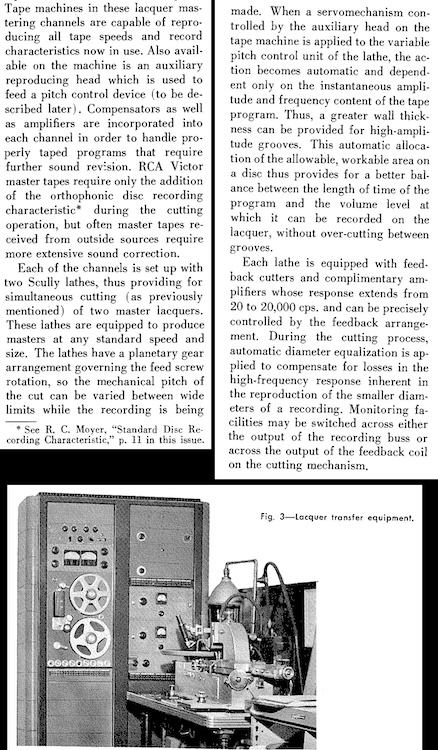
source: RCA Engineer, Vol. 3, No. 2, Oct.-Nov. 1957, pp.9-10
1957年のRCA社内エンジニア向け紀要に掲載された、1957年当時のラッカーカッティング時の流れを解説する箇所
“Description of lacquer transfers”, from 1957 technocal bulletin for RCA’s engineers.
クラシックでは、イコライジングは比較的控えめな利用に留まっていましたが、元録音の最終的なメイクアップ(微調整)であったり、旧音源再発時のバランス調整などに使われることは珍しくはありませんでした。
Although equalization was used relatively sparingly in classical music recordings, it was not uncommon for it to be used in the final make-up (fine-tuning) of original recordings, or for balance adjustments when reissuing old recordings.
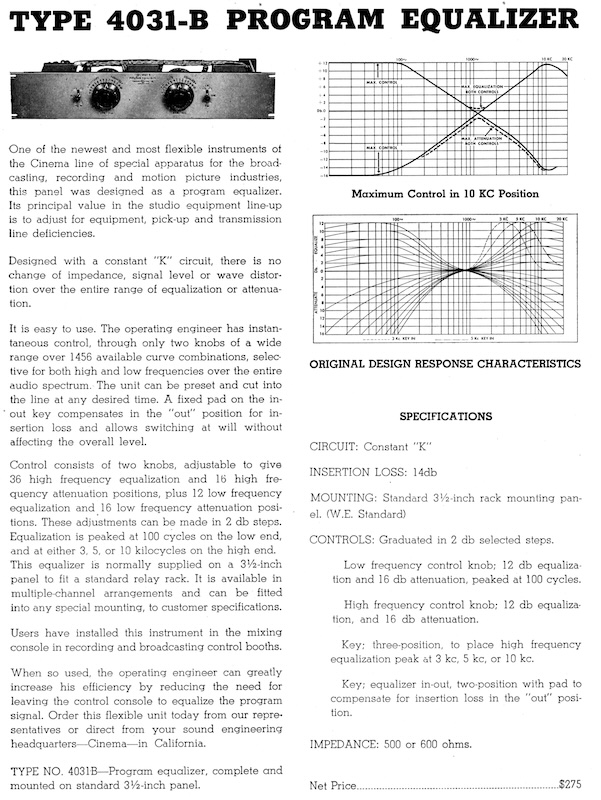
source: Cinema Engineering Company Catalog No. 11AX (possibly in 1951?)
1951年頃に発行されたと思われるカタログに掲載された、Cinema Engineering 4031-B 可変イコライザ

EQP-1A: image obtained from the PULTEC website.

source: Pultec EQP-1A Equalizer Manual (1950s?)
Pultec EQP-1A マニュアルに掲載された、可変イコライザカーブの例
また、テープ編集時やミキシング/マスタリング時のメイクアップのみならず、録音時にマイクプリアンプとミキサーの間にプログラムイコライザ(や後述のコンプレッサなど)を挿入し、狙った音色で録音することも一般的でした。
It has been also common to insert a program equalizer (or compressor, as described in the succeeding subsection) between the microphone preamplifier and the mixer during recordings, as well as make-up during tape editing and mixing/mastering, to record the desired tone.
例えば、1960年代〜1970年代のソウル/ファンクを規範として、いまだにアナログテープとプログラムイコライザ等を駆使し、当時のあの音の感触を彷彿とさせるサウンドを生み続けている Daptone Records のスタジオの解説動画(2009年)が貴重です。
For example, a valuable video (2009) describing the Daptone Records‘ studio, which utilizes analog tapes and program equalizers, etc. to create the sound reminiscent of the feel of “that era”, with Soul/Funk music from 1960s and 1970s as the exemplary sound..
下の動画では、Tube-Tech RM8 ラック にセットアップされた PM1A マイクプリアンプモジュール + EM1A パッシブイコライザモジュール + CM1A コンプレッサモジュール によりマイク入力を受け、さらにミキシング/マスタリング時には Tube-Tech PE1C プログラムイコライザ、LCA2B コンプレッサ/リミッタ、ME1B ミッドレンジイコライザ などが Bosco Mann (Gabriel Roth) 氏と Wayne Gordon 氏によって縦横無尽に活用されていることが確認できます。
The following videos show Bosco Mann (Gabriel Roth) and Wayne Gordon utilizing Tube-Tech‘s PM1A Modular Mic Preamp and DI + EM1A Passive Tube Amplified Equalizer + CM1A Optical Tube Amplified Compressor (all installed in a RM8 Rack) to receive the microphone inputs; and utilizing PE1C Program Equalizer + LCA2B Dual Channel Tube VCA Compressor + ME1B Midrange Equalizer during mixing/mastering.
さらに、特に1950年代〜1970年代においては、シングル盤用に特別なマスタリングを施すことが頻繁に行われていました。ラジオやポータブルオーディオなど廉価な再生システム向けの音作りという側面もありましたし、(音圧競争的に)よりレベルを上げてカッティングする際にカッターヘッドが焼損しないよう高域をあえて抑え気味にする意味もありました。
Furthermore, especially from the 1950s to the 1970s, special mastering was often done for 45 rpm single records. This was partly to create a sound for inexpensive playback systems such as portable audio systems, and radio broadcast, and partly to suppress the high frequencies so as not to burn out the cutter head when cutting at a higher level (in terms of “loudness war”).
近年のCDリイシューで、当時のシングル盤用マスターから直接トランスファーされた音と、LP用カッティングマスターテープからトランスファーされた音、さらにはマルチトラックテープから新たにミックスダウンされた音、これらの音の感触が全然違うことに気付かされることも少なくありませんが、それだけ当時のマスタリング時に積極的に音作りがされていた証左と言えるでしょう。
In recent CD reissues, it is not uncommon to find that the sound transferred directly from the 45 rpm single masters of the time, the sound transferred from the LP cutting masters, and the sound newly mixed down from the multi-track tapes are completely different. This would be the proof of the aggressive sound creation that took place during the masterings at that time.
24.1.7 Hi-Pass/Low-Pass Filters / Limiters / Compressors / De-Essers / LFX
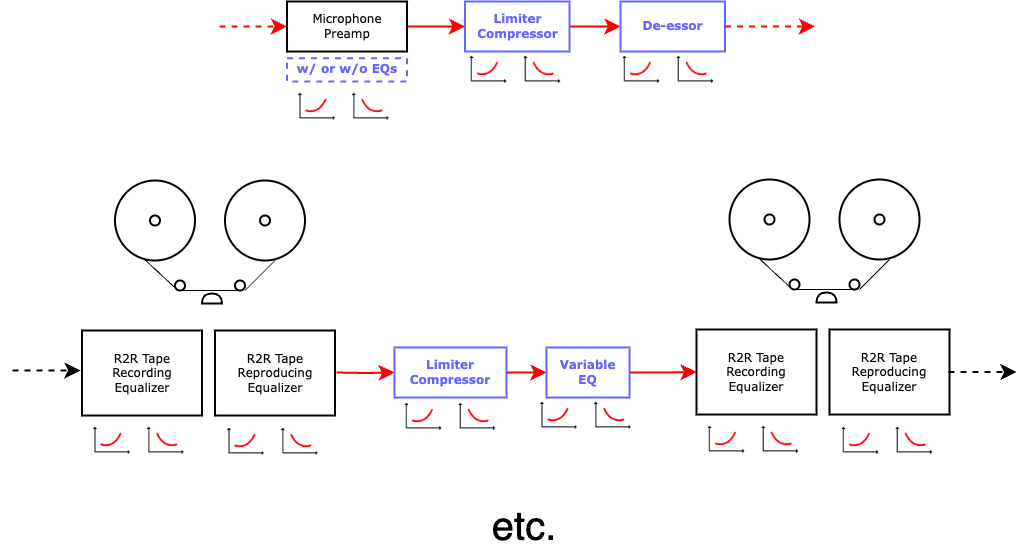
Pultec に代表されるプログラムイコライザの他、ローパス/ハイパスフィルタ、リミッタ/コンプレッサ、ディエッサなども使われていました。
In addition to the program equalizers represented by Pultec EQP-1A, such equipment as low-pass/high-pass filters, limiters/compressors, de-essers were also used.
高域減衰用の ローパスフィルタ、低域減衰用の ハイパスフィルタ は、記録可能な周波数帯域が今よりずっと限られていた時代、そして中高域のサーフェスノイズが多く同時に低域のランブルノイズも多かったシェラック盤の時代には、特に多用されていました。
Low-pass filters (for high-frequency attenuation) and high-pass filters (for low-frequency attenuation) were used in particular in the days of shellac recordings, when the recordable frequency range was much more limited than it is today, and when surface noise (in mid-high) and rumble noise (in low) was more noticeable.
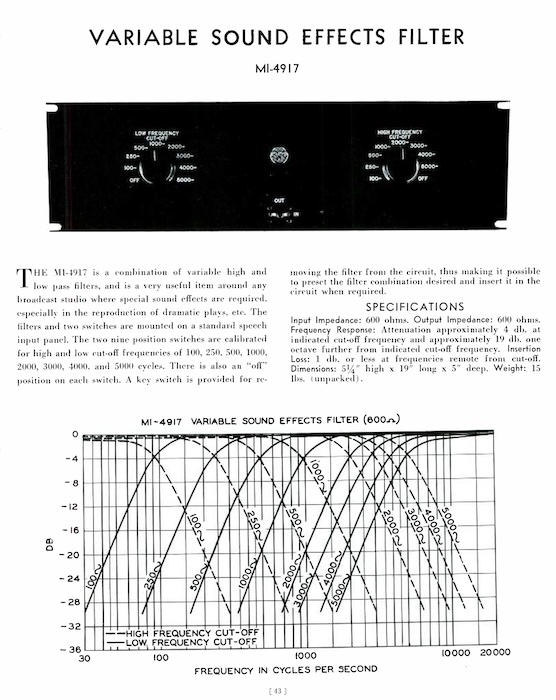
source: RCA Broadcast Equipment 1941, p.43.
1941年 RCA 放送局機器総合カタログに掲載された、ローパス/ハイパスフィルタ製品 MI-4917
RCA Victor では、1940年代の78回転盤の録音(カッティング)時に、RCA XT-2727A ローパスフィルタを使い 10,000Hz 以上をカットしていました。また、LP黎明期に使っていた (Old) Orthophonic 録音カーブも、のちの New Orthophonic(= RIAA)カーブと同等の高域プリエンファシスに対してローパスフィルタを適用し 8,000Hz 以上をロールオフさせていたことなどが知られています。
It is known that in the 1940s RCA Victor used an RCA XT-2727A low-pass filter to cut off frequencies above 10,000Hz when recording (cutting) 78 rpm masters. It is also known that the (old) Orthophonic recording curve, which was used in the early days of LPs, also utilized a low-pass filter to the high-frequency pre-emphasis equivalent to the later New Orthophonic (= RIAA) curves to roll off frequencies above 8,000Hz.
また、後年になると、グラフィックイコライザとローパス/ハイパスフィルタが一体となった製品がスタジオで使われていた例も確認されています。
In later years, we see examples of some products that combined a graphic equalizer and a low-pass/high-pass filter in one unit being used in the recording studios.
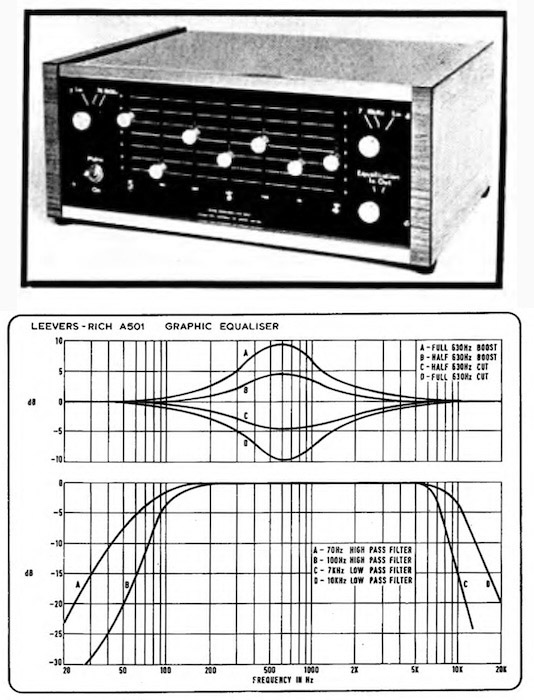
source: Studio Sound, Oct. 1970, p.453.
7バンドのグラフィックイコライザ+ローパス/ハイパスフィルタという構成の Leevers-Rich A501
The Who の “A Quick One”、Cream の “Fresh Cream” などが録音された Ryemuse Sound Studios(のちの Spot Recording Studios)で A501 発表直後に導入されたほか、同時期に UK CBS の Aston Clinton, Aylesbury プレス工場でのマスタリング機材として導入されたことが知られている
1929年提出の特許「US1875157A Compression and Expansion of Range of Energy Level」に端を発し、特に1930年代に映画業界やラジオ局向けで活用が進んだ リミッタ や コンプレッサ も、LP時代が進むにつれ、音圧をあげると同時にオーバーカッティングを防ぐ目的などで、録音時、テープ編集時、カッティングマスター制作時などで積極的に活用されるようになりました。
As the LP era progressed, limiters and compressors, which were originally developed in 1929 (see: U.S. Patent US1875157A Compression and Expansion of Range of Energy Level), then flourish the 1930s especially for the film industry and radio broadcasts, came to be actively used in the disc recording field, such as in recording, tape editing, and final mastering, to increase sound pressure and prevent overcutting.
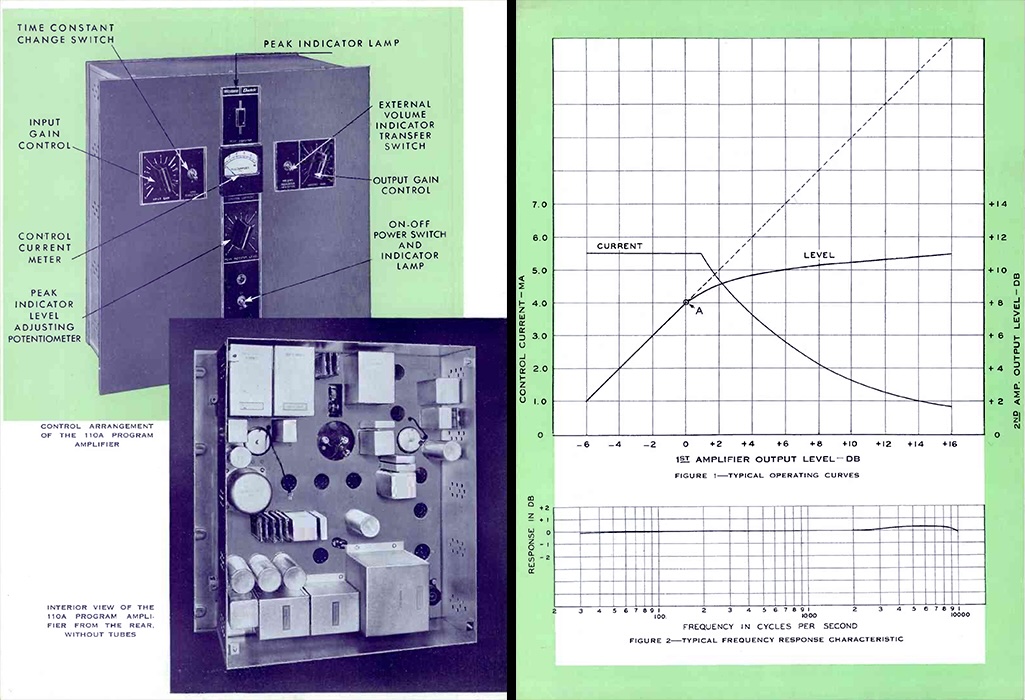
source: Western Electric 110A Program Amplifier Brochure.
世界初のコンプレッサ製品、WE 110A のパンフレットより
数ヶ月遅れで同様の製品 RCA 96-A や Gates 17-B も登場した、とされる
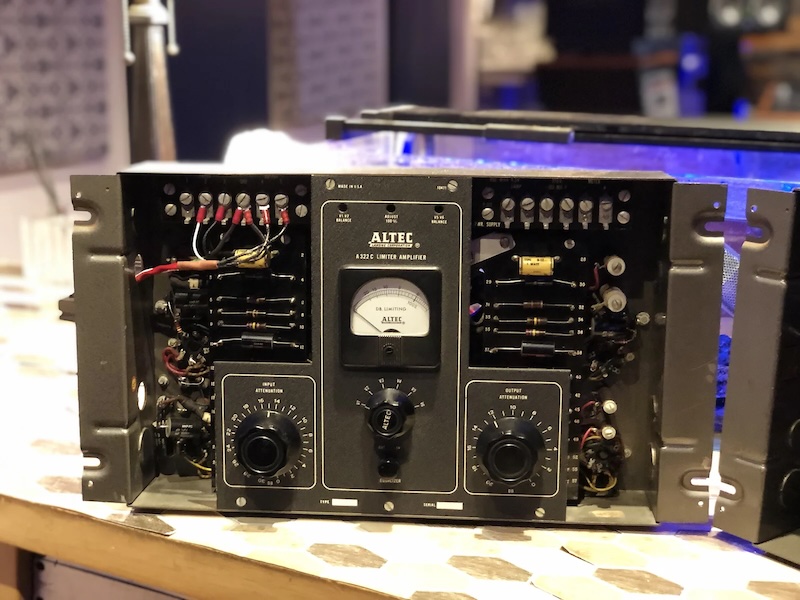
source: Reverb.com.
1947年に登場した Altec A-322C リミッタ/コンプレッサ
出品説明によると、この個体は Van Gelder 氏が使っていた実物とのこと
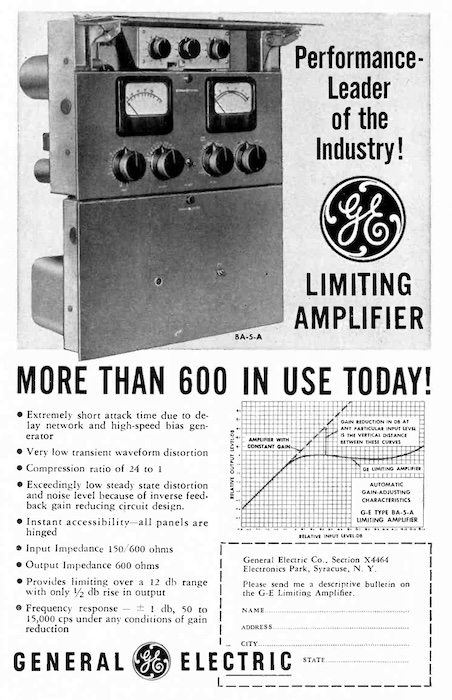
source: Audio Magazine, June 1954, p.49.
Audio 誌1954年6月号に掲載された、GE BA-5A リミッタ/コンプレッサの広告
同じく1930年代に映画業界で開発された、サ行など歯擦音の抑制のためのリミッタの一種、ディエッサ も、ディスク録音の世界に導入されました。
Also developed in the film industry in the 1930s, De-essers (a variation of limiters, reducing/eliminating the excessive prominence of sibiliant consonants) were also introduced to the world of disc recording.

source: “Doing It For Effect… Equalisation”, by Len Lewis, Studio Sound, October 1979, p.51.
最初期のディエッサ(ただし独立した製品ではなくシステムの一部だった)としては、1960年代の Ortofon STL-631 があげられます。歯擦音抑制のほか、高域の高負荷を抑制してカッティングアンプやカッターヘッドを保護するためにも使われました。
One of the earliest de-essers for disc recording (though it was part of a system rather than a standalone product) was the Ortofon STL-631 of the 1960s. In addition to reducing sibiliance, it was also used to protect cutting amplifiers and cutterheads by suppressing high frequency loads.
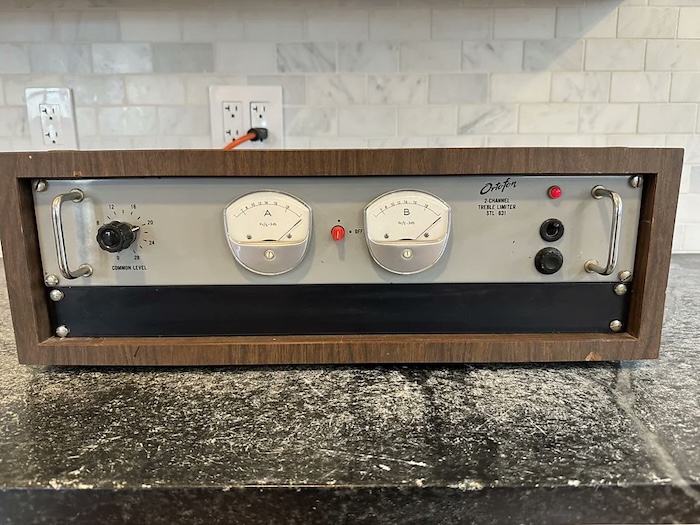
source: Reverb.com.
スタジオに導入された最初期のディエッサ Ortofon STL-631。
1970年代になると、独立装置としてのディエッサとして最初期の製品、Orban 516EC Dynamic Sibilance Controller が登場しました。
In the 1970s, the Orban 516EC Dynamic Sibilance Controller, one of the first de-essers as an independent device, was introduced.
1980年代に入っても、ダイナミックスレッショルドを搭載した dbx 902 が広く使われた他、コンプレッサ/リミッタ/ゲート/ディエッサの統合製品 Orban 424A なども使われました。
In the 1980s, the dbx 902 with dynamic threshold had been widely used. Also used were integreated compressor/limiter/gate/de-esser products such as the Orban 424A.
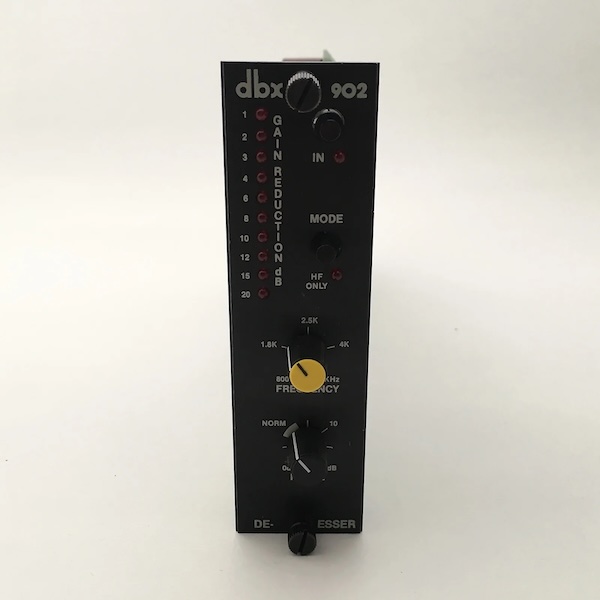
source: Reverb.com.
スレッショルドが不要で、入力レベルに関わらず自然にディエッシング可能なインテリジェント・ディエッサ dbx 902
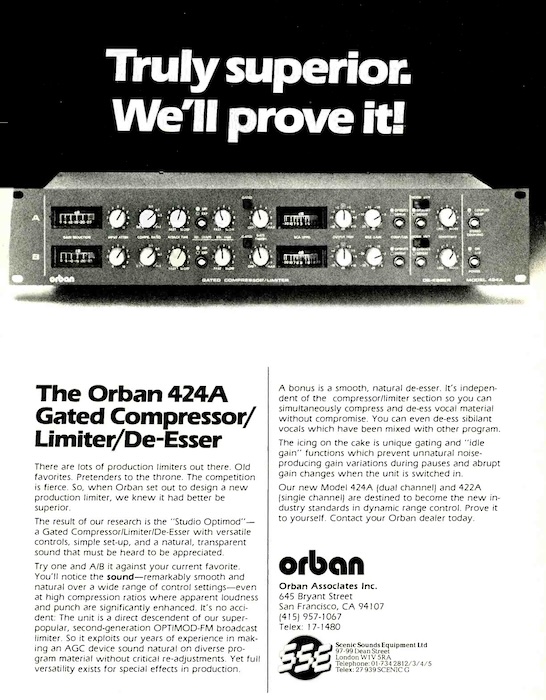
source: Studio Sound, Nov. 1983, p.35.
Studio Sound 誌に掲載された Orban 424A の広告
現在では、dbx 902 をエミュレートした、ディエッサプラグインも販売されています。
Nowadays, a software de-esser plug-in that emulates the dbx 902 is also available.
さらに、より重低域までカッティングする場合、LFX(Low Frequency Crossover)や EE (Elliptical Equalizer) と呼ばれる処理をカッティング時に行います。
In addition, when cutting a sound source that containes even heavier low frequencies, a process called LFX (Low Frequency Croxxover) or EE (Elliptical Equalizer) is used.
これは、ハイパスフィルタを適用して重低域をカットする代わりに、低周波のステレオ信号をモノーラルにブレンドするというもので、溝が浮き上がるなどカッティングエラーを防ぐことができます。
Instead of applying a high-pass filter to cut off the heavy low frequencies, LFX (EE) blends the low-frequency stereo signal into monaural, which prevents groove lifting and other cutting errors.
アナログ時代には、マスタリングコンソール内に組み込まれ、カッティング時に慎重に適用されていましたが、ディジタル全盛期の現在では、マスタリングの段階で LFX 処理を施すこともあるそうです。
In the analog years, LFX was built into the mastering console and very carefully applied at the time of cutting, but in today’s digital heyday, LFX processing is sometimes applied at the digital mastering stage.
iZOTOPE サイト上で公開されている、Jett Galindo 氏のマスタリングに関する記事 中で、LFX 適用前の音源と、Ozone Imager で LFX 適用後の音源を、それぞれ 比較試聴 できます。LFX未適用の音源では、実際にカッティングエラーとなった様子が音で確認できます。
In Jett Galindo’s article about mastering published on the iZOTOPE website, you can compare the sound source before applying LFX and the sound after applying LFX using Ozone Imager. You can hear the actual cutting error with the sound source where the LFX is not applied.
24.1.8 Echo Chambers and Reverberation Machines
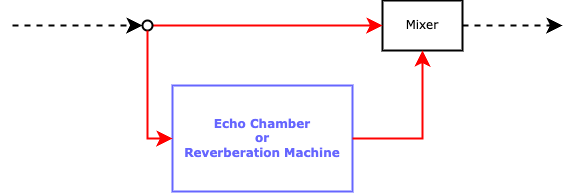
周波数特性を変更するのが主目的ではないものの、狭い録音スタジオでも残響音(リヴァーブ)を付加し、人工的にライブな音にするための装置、すなわち エコーチェンバー や リヴァーブマシン の活用も、主にポピュラー音楽の世界で1940年代頃から盛んに行われてきました。
Although not primarily intended to change frequency response, echo chambers and reverb machines, devices used to add reverberation and create an artificial live sound even in small recording studios, have been widely used since the 1940s, mainly in the world of popular music.
1940年代でも Webster Hall をポピュラー録音でも使うことがあった RCA は、恵まれた例外でした。しかし、ほとんどのスタジオでは当初、大ホールを使わずに残響音を付加するべく、スタジオが入居しているビルの設備をそのままのエコーチェンバーとして利用することが多かったそうです。
RCA Victor was a fortunate exception, as even in the 1940s it sometimes used Webster Hall for popular recordings. However, most studios initially used the facilities of the buildings in which the studios were located as an echo chamber in order to add reverberation without using large concert halls.
Universal Studios の伝説的なエンジニア Bill Putnam 氏は当時を以下のように語っています。
Legendary engineer Bill Putnam of Universal Studios recalled the following:
REST ROOMS, STAIRWELLS, AND OTHER REVERBERATION CHAMBERS
The luxury of a reverberation room specifically designed, built, and dedicated as such was enjoyed by few studios in the late forties. Columbiawas using a stairwell in New York, and the cubic in the spire of the Wrigley Building at WBBH, Chicago. When Universal was still in the Civic Opera Building, we found an excellent men’s room and, except for the times when trespassers ignored the “out of order” sign, we had few problems. (These moments are recorded for posterity on several records.)
トイレ、吹き抜けの階段、その他残響室
特別に設計・建設された専用の残響室(エコーチェンバー)を享受できたスタジオは、1940年代後半の時点ではほとんど存在していなかった。Columbia はニューヨークの階段の吹き抜けを使っていたし、シカゴの WBBH では Wrigley ビルの尖塔にあった真四角の部屋を使用していた。Universal Studios がまだ Civic Opera ビルに入っていた当時、我々は素晴らしい(音響特性を持つ)男性用トイレを見つけ、エコーチェンバーとして利用していた。たまに不審者が「故障中」と書いた張り紙を無視し(てエコーチェンバーとして使用中のトイレに侵入し)たことを除けば、ほとんど問題はなかった。なお、この(侵入した)瞬間は、いくつかのレコードに記録として残っている。
同様のエピソードは、1949年〜1950年に Mercury で A&R を務めていた Mitch Miller 氏の口からも語られています。
A similar story is also told by Mitch Miller, who was A&R at Mercury from 1949 to 1950:
Sound engineers in the 1940s had far less technical equipment at their disposal then today, and when faced with issues such as reverb, they devised unique methods of dealing with the problem. For a time, the men’s room became the natural echo chamber at Liederkranz Hall.
1940年代のサウンドエンジニアが自由に使える技術機材は、現在とは比較にならないほど少なく、リヴァーブやエコーといった残響音の問題に直面した際、彼らはユニークな対処法を考案した。一時期、Liederkranz Hall の男子トイレは自然なエコーチェンバーとなった。
“Bob Fine had done that with me at Mercury,” remembers Mitch Miller. “He was a fabulous engineer. I said, ‘Bob, we’ve got to put a halo around the voice. It sounds like they’re singing into a hunk of wool.’ So he came up with it in a second. He put a speaker in the bathroom—at Reeves Studio in New York, this was—with a mike hanging there. They sent the signal in there, then took a little bit of the sound that came out of the bathroom speaker, and added it to the original mix.”
「Mercury で Bob Fine が一緒にやってくれたんだ」と Mitch Miller 氏は回想する。「彼は素晴らしいエンジニアだった。私は彼にこう言った、『Bob、ヴォーカルに後光を差したいんだ、まるで羊毛の塊に向かって歌ってるような音になってるから』と。そこで Bob はすぐに思いついた。ニューヨークの Reeves Sound スタジオのトイレにスピーカを設置し、マイクを吊り下げたんだ。そこに信号を送り、トイレのスピーカから再生された音をマイクで少し拾い、オリジナルのミックスに加えたんだ。
“Sessions with Sinatra: Frank Sinatra and the Art of Recording”, p.45, Charles L. Granata, Chicago Review Press, 1999Capitol Tower の地下30フィートに建設された有名なコンクリート製エコーチェンバーは、Les Paul や Bill Putnam も設計に関与したものと言われますが、Capitol チェンバー内に設置されたスピーカで再生した音を Altec 21D マイクで拾うことで、あの時代らしいゴージャスな音を作り上げました。同様に、有名な録音スタジオでは独自のエコーチェンバーを持っていました。
The famous concrete echo chamber, built 30 feet underground in the Capitol Tower and said to have been designed by Les Paul and Bill Putnam, utilized Altec 21D microphones to pick up the sound played by loudspeakers in the chamber, creating a gorgeous sound typical of that era. Similarly, some other famous recording studios had their own echo chambers.
Universal Audio 社が販売している Capitol Chambers プラグインの紹介ページで、Capitol Tower 地下のエコーチェンバーの設計図など貴重な写真が見られます。
The webpage for the Capitol Chambers plug-in sold by Universal Audio includes rare photos such as the blueprints of the Capitol echo chambers in the basement of the Capitol Tower.
同じくハリウッドにあった Gold Star Studios は、設立者 David S. Gold 氏自ら設計したユニークなエコーチェンバーを備えており、Phil Spector の「ウォール・オブ・サウンド」を担う重要な設備であったほか、Beach Boys の「Beach Boys Today!」と「Pet Sounds」〜「Smile」期の多くの録音でも使用されました。
Gold Star Studios, also in Hollywood, with its unique echo chamber designed by the founder David S. Gold himself, was a key facility on Phil Spector’s “Wall of Sound”, and was also utilized for many of the Beach Boys’ recordings, including “Beach Boys Today!”, “Pet Sounds”, and the “Smile” period.
Gold Star Studios のエコーチェンバーは、部外者には一切公開していなかったで知られていますが、以下のサイトではそのエコーチェンバー内部の貴重な写真が見られるほか、Gold Star Studios 閉鎖直前のファイナルセッションで録音を行った Bee Gees の Maurice Gibb が、Gold 氏にお願いして見せてもらったそうで、エコーチェンバーの内部を見た唯一の部外者なんだそうです。
The echo chamber at Gold Star Studios is known for not being open to outsiders, but the following site has rare photos of the inside of the echo chamber, and Maurice Gibb of the Bee Gees, who recorded the final session just before Gold Star Studios closed, asked Mr. Gold to show them to him — thus Mr. Gibb became the only outsider who saw inside the echo chamber.
1984年に Gold Star Studio が閉鎖された数ヶ月後、建物は火災で消失しました。
A few months after Gold Star Studios closed in 1984, the building was destroyed by fire.
大掛かりなエコーチェンバーを持っていなかったスタジオでも、アセテート盤にカッティングした直後に別のピックアップで拾うことでディレイを実現するアセテートディレイシステム、スプリングコイルを使ったスプリングエコーチェンバー、プレートリヴァーブ、テープ装置を使ったテープエコーなど、さまざまなリヴァーブ装置を活用し、それぞれ独自の音を作り出していました。
Even studios that did not have large echo chambers utilized a variety of reverb devices to create their own unique sounds. Such devices included the acetate delay system (in which a delay is achieved by picking up a different pickup immediately after cutting on an acetate disc), spring echo chambers (using spring coils), plate reverbs, and tape echoes (using tape devices).
Contemporary の Roy DuNann 氏は、ドライに録音されたマスターテープから、EMT プレートリヴァーブを使ってカッティング時にリヴァーブを付加するなどしていたことが知られています。ただし、Steve Hoffman 氏によると、これは1957年以降の話で、Contemporary の最初期ステレオ盤(1956〜57年)では、マスターテープにリヴァーブ音が収録されているとのことです。
Roy DuNann of Contemporary Records is known to have used EMT plate reverbs from dry-recorded master tapes to add reverbs during master cuttings. However, according to Steve Hoffman, this was after 1957, and Contemporary’s earliest stereo recordings (1956-1957) contain reverbed sounds on the master tapes.
Reverb was added during mastering, with a 4′ by 8′ EMT reverb plate that stood in the shipping room “in the big padded box it came in.” Many years later, some CD reissues of Contemporary recordings sounded oddly dry and sterile because they used the masters as-is, with no reverb added. For JVC’s XRCD series, Akira Taguchi added the reverb digitally.
リヴァーブはマスタリング(カッティング)時に追加され、4フィート × 8フィートの EMT リヴァーブプレートが「梱包された大きな箱のまま」出荷ルームに設置されていた。それから数十年後、Contemporary の CD リイシューが妙にドライで不毛な音に聴こえたのは、リヴァーブが加えられていないマスターをそのまま使ったからである。JVC の XRCD シリーズでは、田口晃氏がディジタルでリヴァーブを加えている。
The Search for Roy DuNann, Steven Cerra, JazzProfilesいまではディジタル化が進み、Capitol チェンバー / Abbey Road チェンバー / Atlantic チェンバーなど、著名なエコーチェンバーの設計図を元に再現したソフトウェアプラグインなどが知られています。
Today, digitalization has vastly progressed, and software plug-ins based on blueprints of famous echo chambers, such as the Capitol Chamber / Abbey Road Chamber / Atlantic Chamber, are known.
24.1.9 Disc Recording Equalizers
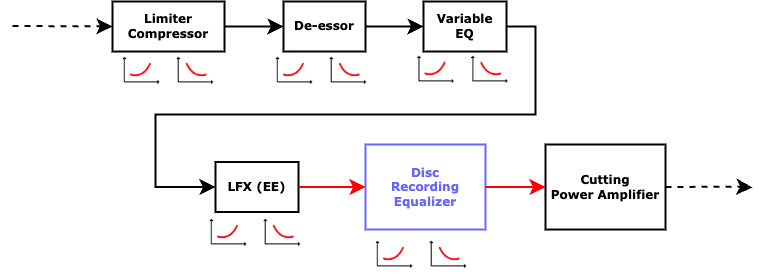
そして、カッターヘッドを駆動するパワーアンプの直前に、ディスク録音イコライザ が挿入されます。
Then, a disc recording equalizer is inserted just before the power amplifier that drives the cutterhead.
カッターヘッドがフラット特性を持っている場合、この録音イコライザのみで録音特性が規定されますが、電気録音黎明期〜マイクログルーヴ盤誕生前後においては、カッターヘッド自体の特性との合計で最終的にディスク録音特性を決定していたため、再生用フォノイコのように単純なものでないことが一般的でした。
If the cutterhead has flat characteristics, the recording characteristics are defined by this recording equalizer alone. However, in the early years of electrical recording and before and after the birth of microgroove records, the final disc recording characteristics were determined by the sum of the characteristics of the cutterhead itself, so it was generally not as simple as phono playback EQ preamps (including archival variable EQs).
電気録音黎明期には、そもそもイコライザを使わずにカッターヘッドの物理的特性によって狙ったディスク録音特性(当時は 200N-FLAT から 300N-FLAT あたり)が実現されていたことは、本稿 Pt.1 で触れました。
It was mentioned in Pt. 1 of my article that in the early years of electrical recording, the physical characteristics of the cutter head (200N-FLAT to 300N-FLAT at that time) were used to achieve the desired disc recording characteristics without using equalizers.
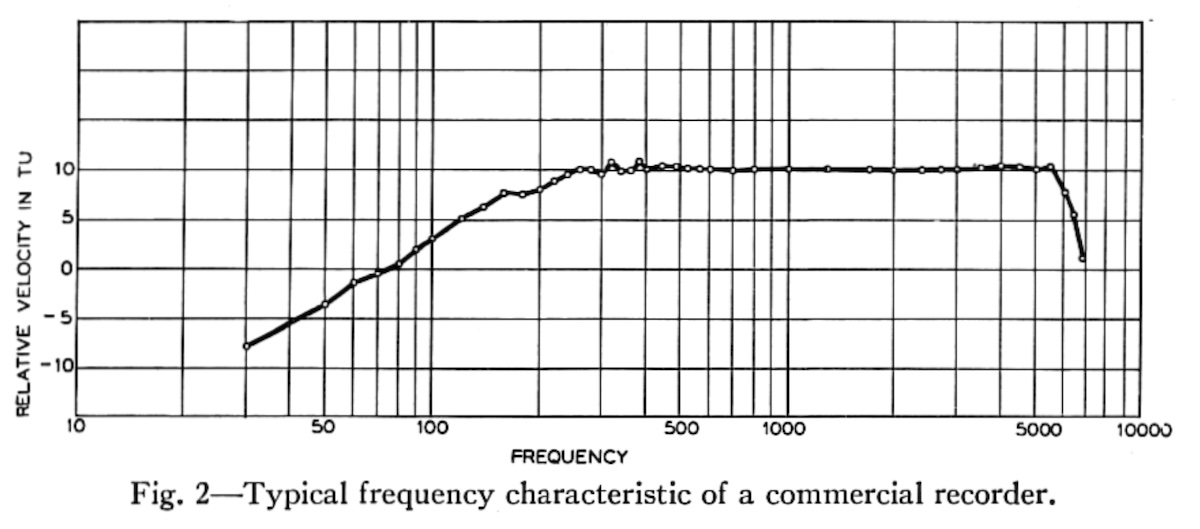
source: “Recent Advances in Wax Recording”, Halsey A. Frederick, Bell System Technical Journal, Vol.8, Issue 1, pp 159-172 (January 1929)
archived at Internet Archive (archive.org)
イコライザなど使わずに物理的に制御された WE ラバーラインレコーダの裸特性
250Hz〜300Hz あたりをターンオーバ周波数として、5kHz あたりまで等速度フラットにされている(上は等加速度にロールオフ)
その後、本稿 Pt.6 セクション 6.1.1 で触れたように、カッターヘッドの裸特性を補正回路で修正し、狙ったターンオーバー周波数を持つ特性に整えるようになります。この頃は、米国では 500N-FLAT あたり、欧州や英国では 300N-FLAT あたり、がそれぞれ一般的でした。
Later, as already mentioned in Pt. 6 Section 6.1.1, the bare characteristics of the cutterhead were corrected with a compensation circuit to adjust it to have the targeted turnover frequency. At this time, it was common around 500N-FLAT in the U.S. and around 300N-FLAT in Europe and the U.K., respectively.
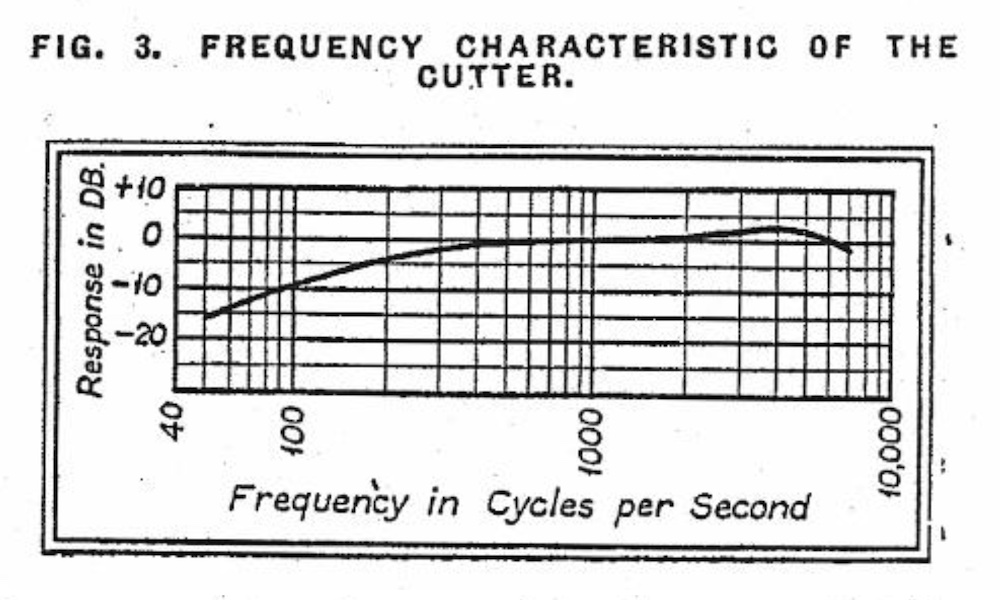
source: “An Instantaneous Recording Head”, George J. Saliba, Communication and Broadcast Engineering, March 1937 (archived at World Radio History), p.8
Presto チーフエンジニアによる、1-B カッターヘッドについての解説記事より、1-B の裸特性
1-B technical article, authored by the Presto’s chief engineer
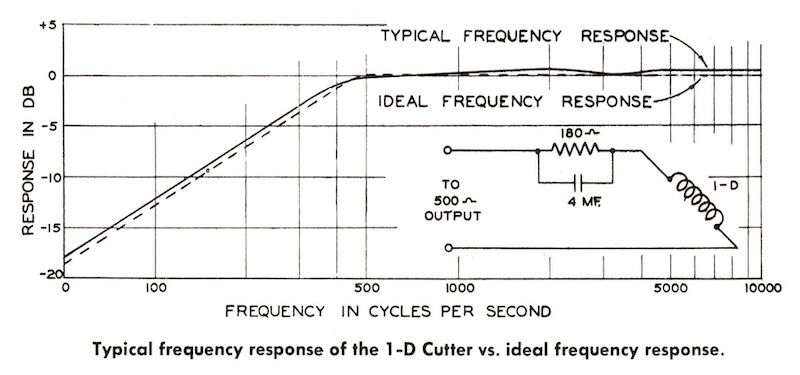
source: “PRESTO Instantaneous Sound Recording Equipment and Discs”, p.19, 1948, Presto Recording Corp. (from steampoweredradio.com)
Presto 1-D カッターヘッドの裸特性に並列RC補正回路を足して、ほぼ 500N-FLAT 特性を実現する例
このように、カッターヘッドの裸特性を補正回路で整えた上で、高域プリエンファシス用(やベースシェルフ用)イコライザを挿入し、カッターヘッド + 補正回路 + 録音イコライザの合計特性で所望の録音特性を実現、という時期が、米国では1930年代中頃〜1940年代末頃まで続きます。本稿 Pt.5 セクション 5.2.3 で紹介した通りです。
In this way, the bare characteristics of the cutterhead were corrected with a compensation circuit, and then a high-frequency pre-emphasis (and bass-shelf) equalizer was inserted to achieve the desired recording characteristics, with the total characteristics of the cutterhead, compensation circuit, and recording equalizer. This process continued from the mid-1930s to the late 1940s in the U.S, as described in Pt. 5 Section 5.2.3.
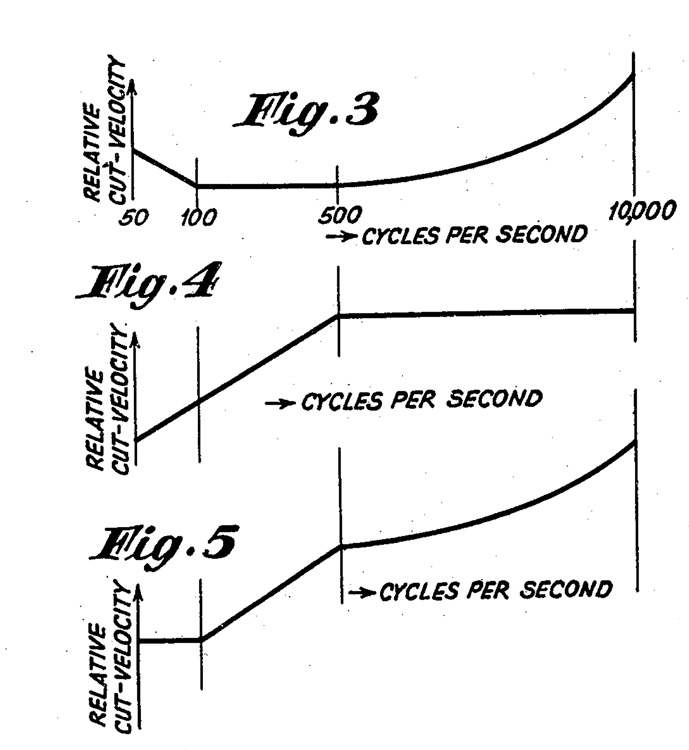
source: “Sound Translating System”, US Patent 2,286,494, Roland A. Lynn & Jarrett L. Hathaway, 1940
Pt. 5 で紹介した、Orthacoustic の特許文書より
Fig.4 がカッターヘッドの電気機械的記録特性(追加で補正回路を使う場合もあり)、
Fig.3 が Orthacoustic プリエンファシスフィルタ(録音イコライザ)特性、
Fig.5 が両者を合計した最終的な記録特性
Fig.4: Cutterhead’s Frequency Response (sometimes accomplished with additional circuits)
Fig.3: Frequency Response of the Orthacoustic pre-emphasis (recording) filter
Fig.5: Final recording characteristics of Orthacoustic, a combination of Fig.4 and Fig.3
1942年という早い時期にトランスクリプション盤向けNAB標準規格(Pt.8 セクション 8.2 参照)が策定された放送局の世界とは異なり、民生用レコードの世界においては、RIAA 録音再生標準規格が策定されるまでは、(社内プラクティスが厳格に定められていたメジャーレーベルを除き)カーブの実現方法もスタジオごとにバラバラであった(さらにスタジオによっては厳密に管理されていなかった可能性もある)ことも十分に考えられます。
Unlike the broadcasting industry, where the NAB Standards for transcription records (see: Pt. 8 Section 8.2) was established as early as 1942, in the consumer record industry, it was quite possible that the method of achieving curves varied from studio to studio (and might not have been strictly controlled at some studios), until the RIAA Recording and Reproducing Standards were established, with the exception of major labels, whose internal engineering practices were strictly defined and complied.
さらに時代が進み、1950年代に入ると、ホットスタイラス技術、そしてフラット特性のフィードバックカッターが普及し、独立した録音イコライザの組み合わせで狙った録音カーブが実現されるようになったことは、本稿 Pt.19 で紹介しました。
As time progressed further into the 1950s, hot stylus technology and feedback cutters with flat characteristics became widespread, and the combination of independent recording equalizers enabled the targeted recording curve to be achieved, as described in Pt. 19.
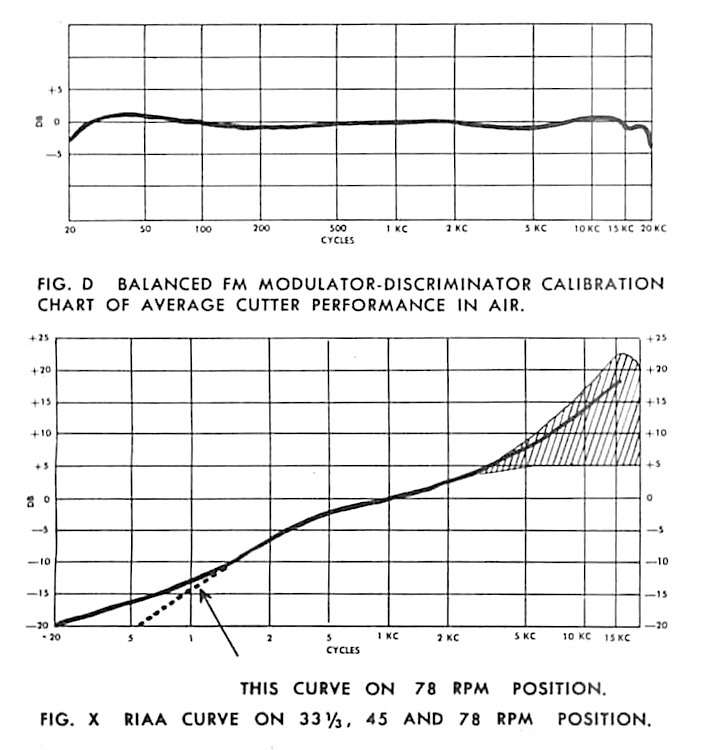
source: “Grampian / Gotham Feedback Cutter System” brochure (possibly mid-late 1950s), by Reeves Equipment Corp.
Shaded area of FIG.X denotes the adjustable range of screwdriver control for high-frequency pre-emphasis
1950年代の Grampian / Gotham フィードバックカッターシステムの小冊子より。
Grampian / BBC ノンモーショナルネガティブフィードバックにより、Type B1/AGU カッターヘッド単体でのフラット特性を確保、
その上で Gotham PFB-150WA カッティングパワーアンプ内の RIAA 録音イコライザを適用する、というソリューション。
グラフ FIG.X の斜線部分が、スクリュードライバで微調整可能な高域プリエンファシスの範囲
また、1954年に米国で RIAA 録音再生標準規格が確立してから1958年ステレオLP登場の頃までには、米国市場でRIAAカーブがほぼ浸透したこともあり、以前は存在していたスタジオ用独立録音イコライザユニットはほぼ姿を消しました。代わりに、カッティングアンプに固定録音イコライザが内蔵されたり、録音システムセット内に専用録音イコライザが用意されることとなりました。
In addition, by the time the RIAA Standard Recording and Reproducing Characteristic was established in the U.S. in 1954 and the stereo LP was introduced in 1958, the independent recording equalizer units had almost disappeared, as the RIAA Standard had almost completely penetrated the U.S. industry and market. Instead, fixed recording equalizers were built into cutting amplifiers, or dedicated recording equalizers were provided within recording system sets.
例えば 本稿 Pt.19 セクション 19.2.3 では、Fairchild 641 録音システムのように、643 ベータアンプで 500N-FLAT 特性とし、644 パワーアンプ内蔵イコライザでベースシェルフと高域プリエンファシスを足して RIAA 録音特性とする、という例もみました。さらにこの Fairchild 641 システムでは、RIAA 録音特性に対してあえて中低域を増幅し高域を減衰させる、恐らくはシングル盤カッティング用であろう 「POP」ポジションを備えていました。
For example, as shown in Pt. 19 Section 19.2.3, the Fairchild 641 recording system consisted of a 643 beta amplifier to obtain 500N-FLAT characteristic, and a 644 power amplifier which had a built-in equalizer to add bass-shelf and high-frequency pre-emphasis, to totally obtain the RIAA recording characteristics. What was more, this Fairchild 641 system had a “POP” position, which amplifies the low midrange and attenuates the highs in response to the RIAA characteristics — probably intended for cutting 45 rpm single records.
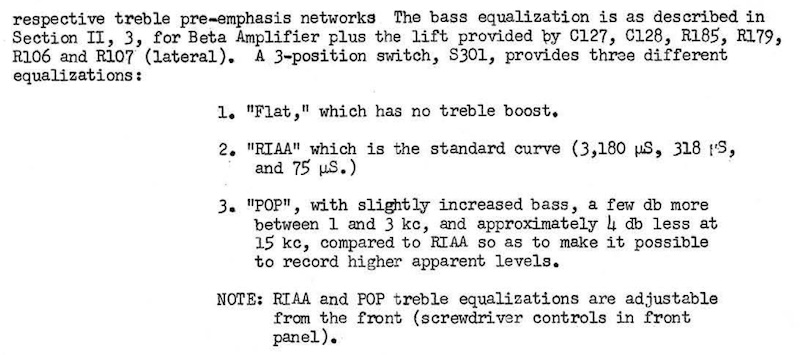
source: Instruction Manual: Fairchild Model 641 Stereophonic Disk Recording System.
“POP” with slightly increased bass, a few db more between 1 and 3 kc, and approximately 4 db less at 15 kc, compared to RIAA so as to make it possible to record higher apparent levels.
「“POP”ポジションは、RIAA ポジションに比べて低域を少し持ち上げ、 1kHz〜3kHz が数dB盛り上げ、15kHz で -4dB としたものであり、見かけ上高いレベルでの記録を可能とする」とある
また、本稿 Pt.19 セクション 19.2.6 でみた Westrex 3D システムにおいては、フィードバックありでも完全フラットではない 3D カッターに対し、30Hz〜1kHz は RIAA 特性、1kHz は定速度特性になるように整える専用のプラグインカードが装備されていました。さらに後段の RA-1574-D カッティングアンプ内の回路によって、システム全体として RIAA 特性が達成される、という仕組みとなっていました。
In the Westrex 3D system (see: Pt. 19 Section 19.2.6), frequency response of the 3D cutterhead was not perfectly flat even with feedback. But by pasing through a dedicated plug-in equalizer card, 500R-FLAT (= RIAA characteristic from 30Hz to 1kHz, and constant velocity above 1kHz) was obtained. Then it was further adjusted by the circuitry in the RA-1594-D cutting amplifier, to achieve the RIAA recording characteristic as a whole.
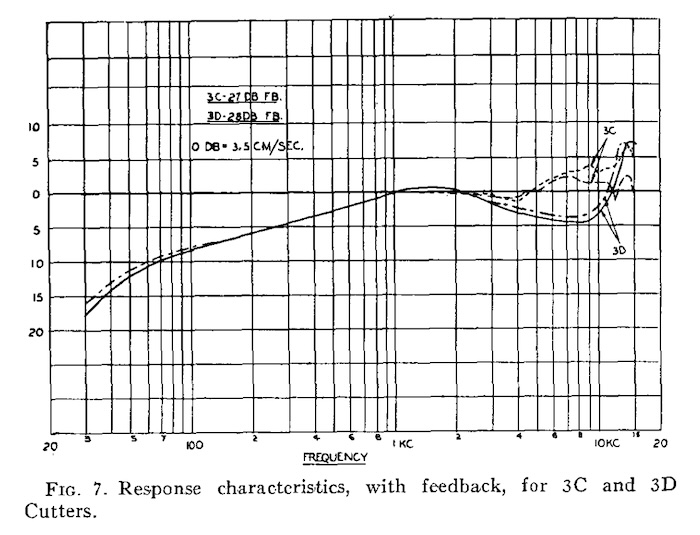
source: “The Westrex 3D StereoDisk System”, C.S. Nelson and J.W. Stafford, Journal of the Audio Engineering Society, Vol. 12, No. 3 (July 1964), pp.178-185.
Even with feedback, the response characteristic is not perfectly flat in velocity.
フィードバックありの状態での Westrex 3C および 3D カッターヘッドの特性。
このままだと十分に定速度フラットではない。
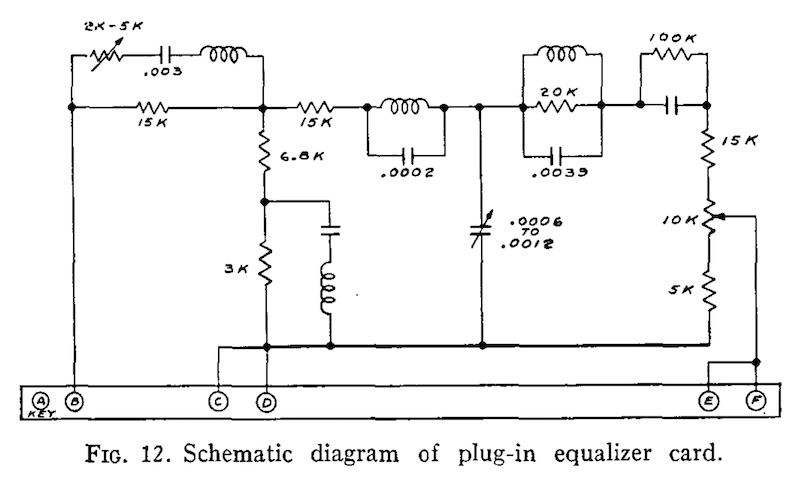
source: “The Westrex 3D StereoDisk System”, C.S. Nelson and J.W. Stafford, Journal of the Audio Engineering Society, Vol. 12, No. 3 (July 1964), pp.178-185.
This plug-in card (for Westrex 3D cutterhead) provides constant velocity equalization from 1kHz to 15kHz, and RIAA equalization from 30Hz to 1kHz.
RA-1574-D 用プラグインイコライザカードの回路図。
Westrex 3D カッターヘッドの記録特性を 1kHz 以下を RIAA 特性、1kHz 以上は定速度フラットに整えるもの。
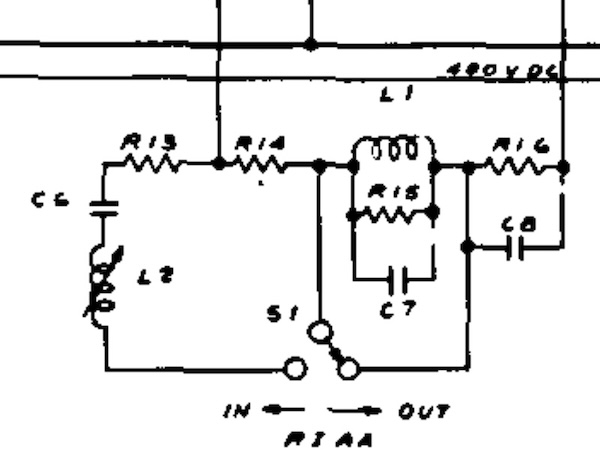
source: “The Westrex 3D StereoDisk System”, C.S. Nelson and J.W. Stafford, Journal of the Audio Engineering Society, Vol. 12, No. 3 (July 1964), pp.178-185.
RA-1574-D 回路図より、RIAA IN/OUT スイッチ部分の拡大。
ここで1kHz 以上を RIAA 特性に整える。
このように、RIAA録音特性の実現は、システム全体の複数回路で行われていることが多く、再生用可変フォノイコライザのように単独ユニットではなかったため、ステレオ時代にあえて改造して非RIAAを実現するのは非現実的ではないか、といった話は、Pt.19 セクション 19.3 で触れた通りです。
Thus, since the RIAA recording characteristics were often achieved in multiple circuits of the overall recording system and not as a stand-alone unit (like a variable phono preamp for playback), it would be impractical to dare to modify the system to achieve non-RIAA in the stereo era, as I did a though experiment in Pt. 19 Section 19.3.
24.1.10 Automatic Diameter Equalizers

ディスク録音(カッティング)時、特にホットスタイラス技術(Pt. 12 セクション 12.2.1 参照)が一般的になる前は、線速度が落ちる内周での高域減衰を補う目的で、内周に近づけば近づくほど高域を持ち上げる、自動補正イコライザ が併用されていました。カッティング時に、カッターヘッドの位置に応じて、高域のプリエンファシスを自動調整するメカニカルな仕組みです(Pt. 17 セクション 17.3.3 コラム 参照)。
During disc recording (cutting), especially until the “Hot Stylus” technique (see: Pt. 12 Section 12.2.1) became common, automatic diameter equalizers was used to compensate for high-frequency loss at the inner diameters where the groove velocity decreased, by adding the high frequency boost as the cutterhead goes to the inner diameter (see also: a column in Pt. 17 Section 17.3.3).
特に16インチ33⅓回転の放送局用トランスクリプション盤やアセテート盤の世界で多く使われました。
Automatic diameter equalizers had been used extensively, especially in the world of 16-inch 33⅓ rpm broadcast transcription records and instantaneous disc recordings.

source: Cinema Engineering Company Catalog No. 10 (possibly in 1950?)
1950年前後に発行されたと思われる Cinema Engineering 社のカタログに掲載された Diameter Equalizer
ホットスタイラスが普及した1950年代中頃〜末以降は、このようなメカニカルな自動イコライザは徐々に姿を消していきましたが、その後のマスタリング現場では、線速度が落ちる内周でも記録特性劣化を抑え十分にカッティングできるよう、内周部分に向けてあらかじめイコライズを施し、LP用カッティングマスターを制作するプラクティスは珍しくありませんでした。
After the spread of the hot stylus technique in the mid-late 1950s, such mechanical automatic equalizers gradually disappeared. On the other hand, it was not uncommon in later mastering practices to produce LP cutting masters by applying equalization to the inner diameters, where groove velocity decreased, could be cut sufficiently with minimal deterioration.
iZOTOPE サイト上で公開されている、Jett Galindo 氏のマスタリングに関する記事 中で、同一音源を最外周と最内周にカッティングした 音のサンプル を聞くことができ、線速度の違いによって記録された音がどれだけ変わるかを確認できます。
In Jett Galindo’s article about mastering published on the iZOTOPE website, you can hear samples of the same source cut to the outermost and innermost diameter to understand how different groove velocity change the recorded sound.
24.1.11 Cutterheads and associated Equalizers
カッターヘッド自体の応答特性 も当然ながら無視できません。
It goes without saying that the response characteristics of the cutterhead itself cannot be ignored.
特に初期は、カッターヘッドごとの特性のばらつきが大きかったそうで、例えば英国の Blumlein システム(Pt. 3 セクション 3.3)では、駆動するパワーアンプとカッターヘッドの間に挿入されるパッシブイコライザユニットは、カッターヘッドごとに個別のものが用意され、異なるカッターヘッドとイコライザの組で使わないように厳格に管理されていたそうです (出典: “Manual of Analogue Sound Restoration Techniques”, Copeland, 2008, pp.127-128)。
Especially in the early years, there was an innevitable variation in the response characteristics of each cutterhead. For example, in the Blumlein recording system (Pt. 3 Section 3.3), “each individual cutterhead had its own equaliser, and there were strict instructions to prevent cutterheads and equalisers being swapped.” (source: “Manual of Analogue Sound Restoration Techniques”, Copeland, 2008, pp.127-128)
技術が進歩するにつれ、特性のばらつきは減少していきましたが、それでもカッター針の摩耗具合、カッターヘッドユニットの使用頻度や負荷によって特性は一定ではないため、テストカットをするなど特性計測をしたのち、微調整をする必要があります。
As technology has advanced, the variation in cutterhead characteristics has decreased. However, characteristics are still not constant depending on the wear of the cutter styli, frequency of use of the cutterhead units, mechanical load, etc., so it is necessary to make fine adjustments after measuring charactersitics by conducting test cuttings.
本稿 Pt.21 セクション 21.2.5 のコラム でも紹介しましたが、Gotham Audio の社長 Stephen F. Temmer 氏がが1966年に配布したドキュメント「Trouble Shooting in Disk Cutting Systems」では、NAB Test Record の特性をリファレンスとしてカッティングレベルをあわせる方法について説明があります。
The document “Trouble Shooting in Disk Cutting Systems” distributed in 1966 by Stephen F. Temmer, president of Gotham Audio, recommends the use of the NAB Test Record as a reference, to align the cutting level of the system (see also: column in Pt. 21 Section 21.2.5)
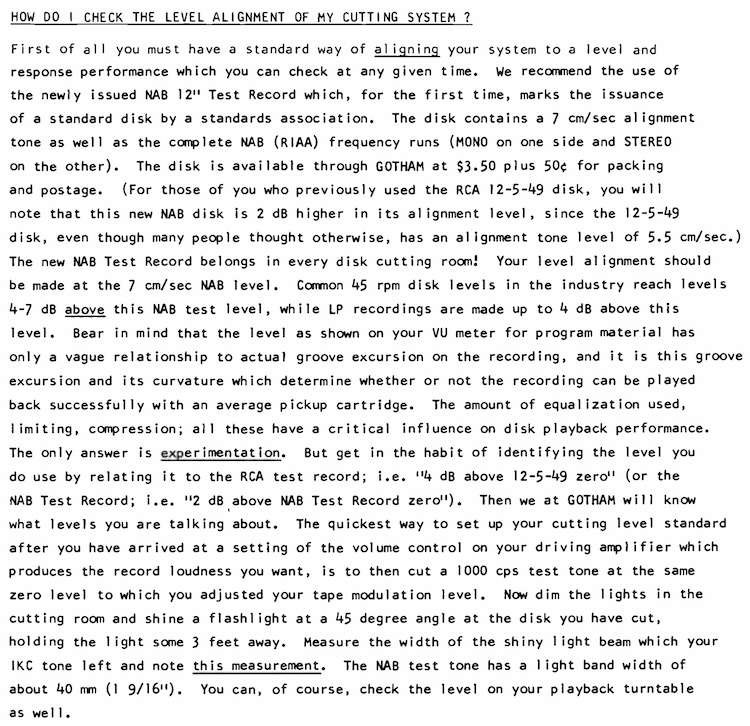
excerpt from “Trouble Shooting in Disk Cutting Systems” by Stephen F. Temmer.
source: Gotham Audio 1966 Brochure.
長らく業界標準の RCA Victor 12-5-49 に代わり、今後はカッティング時には NAB Test Record をリファレンスにすべし、と記載がある
また、カッティングシステムの記録特性の最終チェックには、1kHz 以上は Buchmann-Meyer パターンの目視確認をを行い、1kHz 以下については実際にアセテート盤に記録して再生して誤差を計測する方法が推奨されています。
For the final check of the recording characteristics of the cutting system, the document also recommends visual checks of the Buchmann-Meyer pattern for 1kHz and above, and for 1kHz and below, the error be measured by actually playing back the recorded sound on a lacquer disc.

excerpt from “Trouble Shooting in Disk Cutting Systems” (Stephen F. Temmer).
source: Gotham Audio 1966 Brochure.
「NABテストレコードを再生し、その周波数特性の誤差を記録したのち、アセテート盤に同一音源を記録しそれを再生、前者との誤差を計測することで、カッティングシステムの 1kHz 以下の特性が計測できる」とある
これらに加えて、フィードバックの極性、カッター針の形状、ホットスタイラスの設定、カッターヘッドの装着角度、カッターヘッドの移動位置とセンターとのずれ、などのチェックについて解説されています。
In addition to these, the document also describes checks for feedback polarity, cutter stylus shape, hot stylus settings, cutterhead mounting angle, cutterhead movement position and deviation from center, and more.
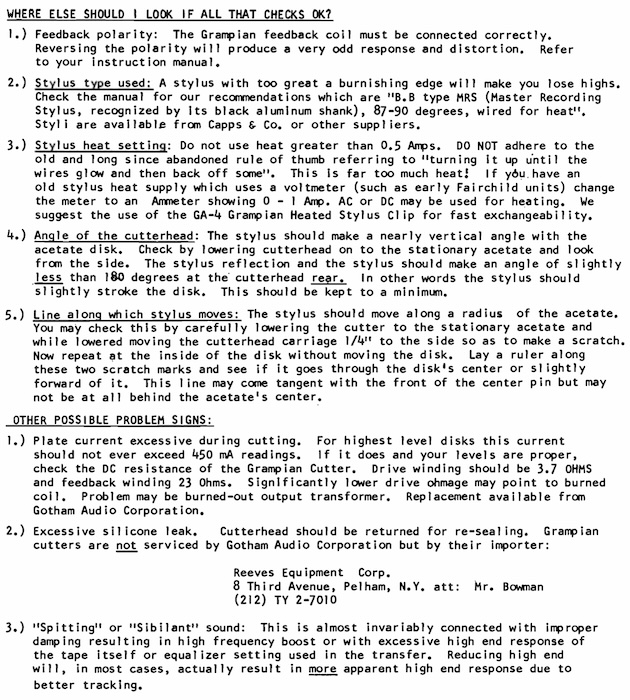
excerpt from “Trouble Shooting in Disk Cutting Systems” (Stephen F. Temmer).
source: Gotham Audio 1966 Brochure.
その他、カッティング前にチェックする必要のある項目の説明
これらの厳密な記録特性チェックや較正は、多くのスタジオで行われていたはずですが、もしかしたら、小規模の独立系スタジオが乱立していた1950年代〜1960年代には、記録特性がずれたまま(あるいは意図的にずらして?)カッティングが行われた事例があってもおかしくないかも、と思わされます。
Although these rigorous recording characteristic checks and calibrations must have been performed in many studios, it could be possible that in the 1950s and 1960s, when small independent studios were in disarray, there may have been cases where cutting was performed with misaligned (or intentionally misaligned?) recording characteristics.
24.1.12 Pressing at Plants
このような経路を通過して最終的にラッカー盤に記録されたのち、ラッカー盤はプレス工場に送られ、メッキ処理を順に施して「メタルマスター」(凸型)、「メタルマザー」(凹型)、「スタンパー」(凸型)を製造、このスタンパーをプレス機にセットし、レコード盤が製造されます。
After being finally recorded on a lacquer disc through these procedures, the lacquer disc was sent to a pressing plant, where plating was applied in sequence to produce a “metal master” (convex), “metal mother” (concave), and “stamper” (convex), which were then set on a pressing machine to produce the records.
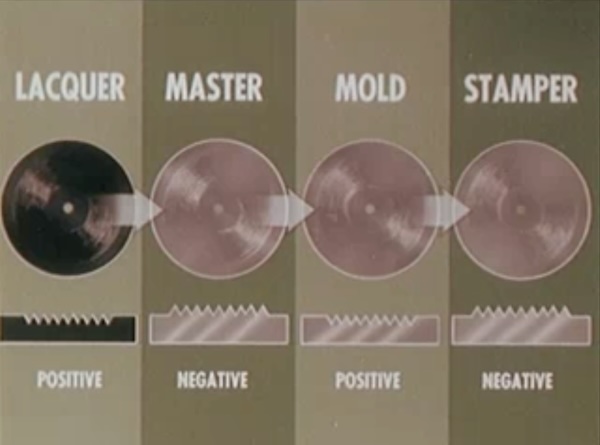
source: “Sound And The Story”, RCA Victor, 1956.
レコードの原材料である コンパウンド は、時代によって、製造元によって、プレス工場によって、多くの違いがありました。クラシックLPには高品質のコンパウンド、シングル盤にはプレス後切り取った端材を再利用したリユースのコンパウンド、廉価盤には配合を変え安価に済ませたコンパウンドであったり、インジェクションモールドの場合は廉価なポリスチレンを使う場合もありました。
Vinyl compounds, the raw material for vinyl records, varied widely from era to era, from manufacturer to manufacturer, and from pressing plant to plant. For example, highest-quality compounds were used for classical LPs; reused compounds (“flash” or trimmed-off edges after pressings etc.) were used for 45 rpm single records; cheaper compounds were used for budget records; cheaper polystyrene was used for injection molding, etc.
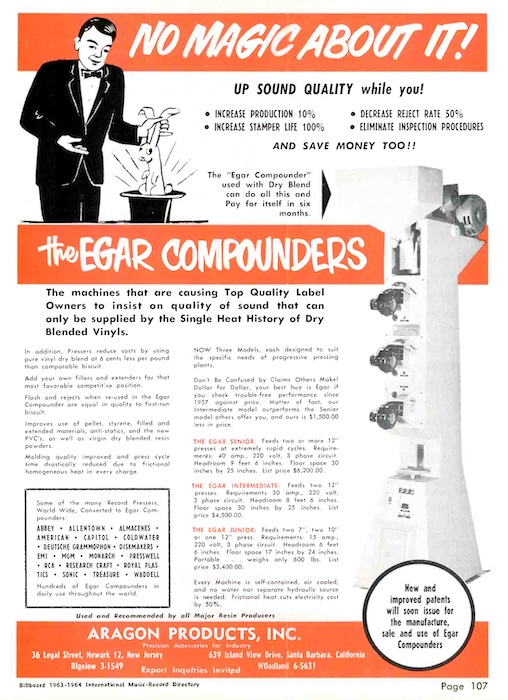
source: Billboard 1963-64 International Music-Record Directory & Buyer’s Guide, p.107.
大手プレス工場でも多く採用されていた、Aragon Products 社製の Egar コンパウンド製造機の広告
“Add your own fillers and extenders for that most favorable competitive position” とか “Flash and rejects when re-used in the Egar Compunder are equal in quality to first-run biscuit” といった宣伝文句が見られる
この材質や配合比、製造工場、製造時期によっても、音が変わってしまうことになります。
So, the sound will vary depending on which material was used, blending ratio of materials, at which pressing plant, and when it was pressed.
さらには、特定のスタンパー を使ってプレス可能な枚数はおおよそ1,000枚〜2,000程度と言われており、1枚目にプレスされたレコード、100枚目にプレスされたレコード、1,000枚目にプレスされたレコード、2,000枚目にプレスされたレコード、これらもそれぞれ音が多少は異なることになります。
Furthermore, it is known that the number of copies that can be pressed using a particular stamper is approximately 1,000 to 2,000. In other words, the first pressed record, the 100th pressed record, the 1,000th pressed record, and the 2,000th pressed record will all sound different from each other.
まったく同じ日に、全く同じ材質を使って、全く同じスタンパーで、全く同じプレス機で製造されていても、1枚1枚の音が微妙に違う可能性がある、これがアナログレコードの「アナログ」たる所以なのでしょう。
Even if they were made on exactly the same day, using the exact same vinyl compounds, with the exact same stamper, and on the exact same pressing machine, each disc may have a slightly different sound — which is probably why analog records are “analogue”.
もちろん、スタンパーの大元である ラッカー盤 が異なれば、音も異なります。これは、「初盤」と呼ばれる最初期盤を探求・蒐集されている方が多いことから、よく知られていることでしょう。
Of course, different lacquer discs (thus different stampers) will sound different. This is well known by many enthusiastic collectors who seek out and grab the earliest pressings possible, often called “first pressing”.
一方、ファーストラッカーだからといって必ずしも最良とは限らない(セカンドラッカー以降はカッティングエンジニアは皆手抜きするのか?的な)、とも言える気はします。この件については、Steve Hoffman Music Forum のスタンパーに関する議論中、Raunchnroll さんが書かれたコメントを引用するに留めておきます。
On the other hand, I feel that it could be said that just because it is a disc manufactured from the first lacquer does not necessarily mean it is always the best (i.e. do all cutting engineers cut corners for second lacquer and beyond?) On this subject, I’ll just quote a comment made by Raunchnroll in the Steve Hoffman Music Forum’s discussion of stampers.
The matrix generally gives you the overall sound for that cutting. After all, it has a certain mastering built into it. Another matrix may sound a tad different if a different engineer cut it or it was done on a different lathe or a different tape was used. Generally, and most of the time, I’ve found the earlier the matrix the better the balance/sound/mastering/presence, but thats only a generality because as Steve says, it depends on the quality of the cutting. And we all like different flavors for our music.
マトリクス情報は一般的に、その特定のカッティングの全体的な音(の傾向)を教えてくれる。結局のところ、特定のマトリクスには、特定のマスタリングが組み込まれていると言っていい。別のエンジニアがカッティングしたり、別のカッティングレースを使ったり、別のテープからカッティングしたりすれば、異なるマトリクスの版の音は異なってくるだろう。一般的に(そしてほとんどの場合)、マトリクス番号が若ければ若いほど、バランス/サウンド/マスタリング/プレゼンスが良くなる、と私は感じている。しかしこれは、Steve (Hoffman) が言うように、カッティングのクオリティに依存するものであるから、あくまで一般論に過ぎない。さらに我々は、自分が聴いている音楽に対してそれぞれ違う好みを持っている。
Take a bunch of copies of the same record with the same lacquer code or matrix. Put a particular passage on one by one and sit back and listen to a minute or so of each, then change them out quickly, playing the same passage. Even with the very same matrix you may hear differences – one that sounds more present or in-the-room, another might sound overall a tad ‘smaller’, one might have a touch more low end, or, lack the vocal clarity of the last pressing you heard. Or…for inexplicable reasons…one pressing may just not sound ‘right.’
同一のマトリクス情報(ラッカーコード)を持つ同じレコードを何枚も用意して、特定のパッセージを順にかけ、素早く交換しながらそれぞれを1分ほど聴いてみる。そうすれば、同一マトリクスの盤同士であっても、違いが聞き取れるかもしれない。例えば、ある盤ではより存在感のある、その場にいるような音に聴こえ、またある盤では全体的に少し「小さな」音に聴こえたり、はたまた別の盤では低域が強目に出ていたり、最後に聴いた盤ではヴォーカルの明瞭さに欠けていたり、そんな感じだろう。あるいは、不可解な理由から、ある盤の音が「正しくない」ように聴こえる場合もあるだろう。
These differences could be the result of the stamper used, or the amount of the vinyl in the puck, or the temperature as it was pressed and cooled. Down at the micro level, every record is unique. Theres a lot of things going on as records get churned out in droves. Get a record hot off the press after a new stamper is in place and compare it to one that comes from the end right before the stamper needs to be replaced, and you’d probably hear some audio deterioration and/or differences.
これらの違いは、使用されたスタンパー、プレス時に使用されたバイナルコンパウンドの量、プレスされ冷却された時の温度、そのようなものの結果かもしれない。ミクロのレベルでいうと、全てのレコードはそれぞれ異なっている。レコードは大量に生産されるため、さまざまなことが起こりうる。新しいスタンパーが(プレス機に)装着された直後にプレスされたレコードと、スタンパーが交換される直前のレコードを聴き比べれば、おそらくオーディオ的な劣化や違いが聴き取れるであろう。
Raunchnroll's comment (Jun. 20, 2013) on “A question about vinyl stampers”, Steve Hoffman Music Forum
>> So for big sixties albums that sold millions the mastering engineer would have needed to cut the record, what, over ten times? Would they have done a number at a time?
Either that or a number of copy tapes were made of the master and sent out to facilities so additional lacquers could be cut. The basic process of manufacturing seems to offer a number of ways of duplication. Its clear that some popular records had several initial master cuttings done at one facility at once. Look at the Led Zep II by Ludwig at Sterling Sound: three lacquers appear to have been cut right from the start (A, B, and C). And it was not uncommon for larger labels, say Atco/Atlantic, to send lacquers to a facility like Long Wear Plating for the metal processes (hence the ‘LW’ scribe seen in so many Atco/Atlantic Lps). From there, metal parts could be farmed out to pressing facilities.
>> では、何百万枚も売れた1960年代のアルバムでは、マスタリングエンジニアは10回以上もカッティングする必要があったんでしょうか? 一度に何枚もカッティングしたんでしょうか?
あるいは、マスターテープから何枚のコピーテープが作られ、マスタリングスタジオに送られ、複数のラッカーがカットされたか、だ。基本的な製造工程では、複製方法がいくつもあるようだ。Sterling Sound の Ludwig による Led Zeppelin II を見れば、3枚のラッカー盤が最初からカットされていたように見える(A、B、C)。また、例えば Atco/Atlantic のような大レーベルでは、メッキ処理のために Long Wear Plating 社 のような外部スタンパー製造業者にラッカーを送ることは珍しくなかった(そのため “LW” の手書きマトリクスが入る)。そして製造後のメタルパーツがプレス工場に送られた。
24.1.13 Reproducing with Home Equipment, with Human Auditory
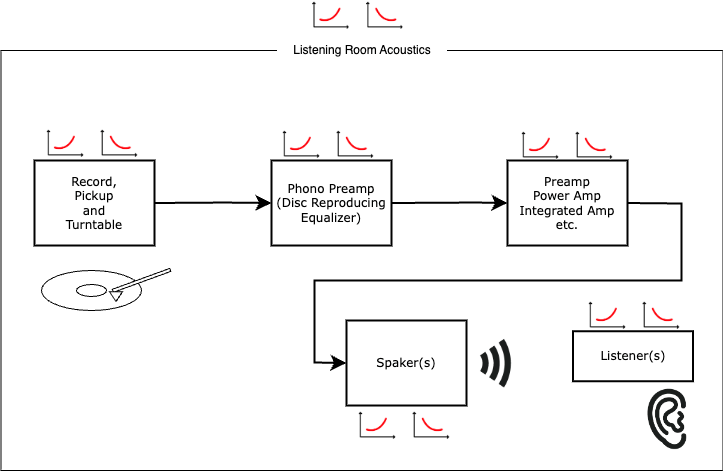
そして忘れてはならないのは、われわれ消費者が最終的にメディアを再生して音を出す際の 再生環境(機器、空間)でしょう。
Last of all, we must not forget the playback environment (equipment and space) in which we, the consumers, ultimately play the media to reproduce sound.
最新の本格的なオーディオコンポーネントで構成されたシステムで聴く場合、ヴィンテージ機器で構成されたシステムで聴く場合、ポータブル電蓄で聴く場合、ヘッドフォンで聴く場合、当然ながら千差万別です。設置位置やエアボリューム、試聴位置によっても受け取る音は変わります。
When listening to a system consisting of the latest authentic audio components, a system consisting of vintage equipment, a portable record player, or headphones, we will listen to a thousand different sounds. Also, the sound you receive will vary depending on the installation position, air volume, and listening position.
もちろん、ほぼ同等の構成のオーディオシステムであっても、個々のオーディオ機器の特性の違いが存在します。以下は、1957年のRCA社内エンジニア向け紀要に掲載された「Factors in Phonograph Record Reproduction」の一節です。
Of course, differences in the charactereistics of individual audio equipment exist even in audio systems of roughly equivalent configuration. The following is a quoted section from “Factors in Phonograph Record Production”, published in the 1957 RCA in-house inegineer’s bulletin.
Although virtual standardization has been achieved by the recording industry in general, and a reproducing instrument can be adjusted for optimum reproduction on most records, some problems still arise because all manufacturers do not stick strictly together on standards.
レコード業界全体では事実上の標準化が達成され、再生機器はほとんどのレコードで最適な再生ができるよう調整可能となったが、すべてのメーカが厳密には規格に準拠していないため、依然としていくつかの問題が生じている。
For example, most record companies s:pecify either their recording characteristic or the proper playback response, but this is viewed as a frequency response specification only. It has been found that records still vary one from another, the greatest difference being one of recording level. Wide variations have been observed with some records being made at higher than average level. This is noted primarily on popular 45’s. It is therefore necessary to design amplifier circuits that can accept this higher level without distortion. It has been found that distortion inherent in the record universally accompanies such levels.
例えば、ほとんどのレコード会社は、録音特性または適切な再生レスポンスのいずれかを指定しているが、これは周波数レスポンスのみの仕様とみなされている。レコードはまだ個体差があり、最大の違いは録音レベルであることがわかっている。レコードの中には、平均レベルより高いレベルでカッティングされているものがあり、大きなばらつきが観測されている。これは主にポピュラーの45回転盤でみられる。したがって、この高いレベルを歪みなく受け入れられるアンプ回路を設計する必要がある。このようなレベルにはレコード特有の歪みがつきものであることも判明している。
For a more complete treatise on the subject of the entire reproducer of disc records, please refer to the article, “Some Practical Aspects of High Fidelity Design” in the August-September, 1956 issue of the ‘RCA Engineer.’
ディスクレコードの再生装置全体に関するより完全な論考は、RCA Engineer 1956年8〜9月号の記事「Some Practical Aspects of High Fidelity Design」を参照されたい。
“Factors in Phonograph Record Reproduction”, by Roy S. Fine, RCA Engineer, Vol. 3, No. 2, Oct.-Nov. 1957, p.27そして、最終的に音を受け取るトランスデューサは、人間の耳(や身体全体)です。聴覚特性や触覚特性によっても、聞こえ方が変わることになります。
What’s more, the transducer that ultimately receives the sound waves is human ears (and the entire body). Auditory and tactile characteristics will also change the way we hear.
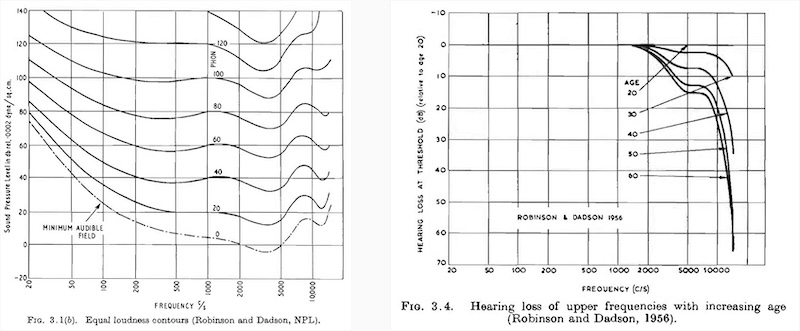
source: “High Quality Sound Reproduction”, James Moir, Chapman & Hall, 1961, p.46 & 48.
左:等ラウドネス曲線(超感情の音の強度を周波数 x 音圧のグラフとしたもの)
右:加齢と共に聴こえ辛くなる高周波域
さらには、神経を通じて音という情報を最終的に受け取るのは、我々の脳です。ひとりひとり違う個性・感性があるわけですから、同じ環境で同じ音を聴いていたとしても、感じ方は全く異なってもおかしくはありません。
Moreover, it is our brain that ultimately receives the information of sound through our nerves. Since each of us has a different personality and sensibility, it is not surprising that we feel completely differently even when we hear the same sound in the same environment.
24.2 Recording/Reproducing EQ is NOT the only factor to define overall sound characteristics
このように、さまざまな音響特性や周波数特性を持つ複数の機器を経由して、最終的にメディアに刻まれ音信号の溝として記録されます。現代では音信号がディジタル符号化され記録されます。
In this way, the original sound is captured and passed through multiple devices with various acoustic and frequency characteristics, before finally being engraved on media and recorded as a sound groove (or, in modern technology, the sound data is digitally encoded and physically stored).
しかも、録音サイドだけでも、録音エンジニア、ミキシングエンジニア、マスタリング(カッティング)エンジニア、それぞれの嗜好、ポリシー、秘伝のテクニックなどがあり、同時に使用する機器やセッティングも異なります。極論すれば、温度、湿度、気圧、電源コンディションですら、一切関係がない、とは言い切れないかもしれません。
What’s more, on the recording side alone, recording engineers, mixing engineers and mastering (cutting) engineers all have their own preferences, policies, and heirloom techniques; they all use different equipment and settings at the same time. In the extreme, it may be possible to say that temperature, humidity, air pressure, and even power supply conditions have to do with the recording process.
そしてさらに、さまざまな音響特性や周波数特性を持つ再生機器・再生環境で、さまざまな聴覚特性を持ち、さまざまな感性を持った個々のリスナーによって、聴かれることになります。
Moreover, they will be listened to by individual listeners, with different auditory characteristics and sensibilities, in different playback equipment and environment with various acoustic and frequency characteristics.
この際、なにをもって「フラット」というのか。そして、その「フラット」とは何を基準としたものなのでしょうか。
At this point, what consistues “flat”? And what is the standard for such “flatness”?
レコード再生におけるフォノEQカーブだけに焦点を絞るとするならば、主観的な聴感での印象チェックではなく、(周波数チェックレコードなどを使ってフラットな特性であることが確認された再生環境で)レコードを再生した音と、カッティング用マスターテープの音(に近い特性を持った音源)、この両者の比較においてのみ、その判断ができるのではないか。その様に考えることもできるでしょう。
If we were to focus only on the phono EQ curve in record playback, we could make such a judgement only by comparing the sound of a record played back (with a playback environment where the characteristics have been confirmed to be flat using frequency check records, etc.) and the sound of a master tape for cutting (or a sound source with characteristics very similar to those of a master tape), rather than by checking subjective listening impressions.
ここで、非常に興味深いことに、「ステレオ盤以降でも非RIAAカーブである」と主張される方のほとんどが、(ミキシング、マスタリング時に音を積極的にいじらない)クラシック音楽のレコードについてはほとんど言及しておらず、むしろ時代ごとの音のトレンド、スタジオならではの音の感触の特徴、シングル盤/ラジオ放送向け、など、積極的に音作りをすることの多い、ポップス、ロック、ジャズ、R&B、ソウル、… などのレコードについて言及しているように見受けられます。
It is very interesting to note here that most of those who claim “many stereo records cut with non-RIAA curve” rarely mention classical LPs (where the sound is not aggressively tweaked during mixing and mastering). Rather, they seem to be referring to the records of Pop, Rock, Jazz, R&B, Soul, etc., most of which had been actively created for sound trends of each era, characteristics of the unique studio sound feel, for singles and radio broadcast, and so on.
また、1950年代以降、あるスタジオが同時期に、音楽ジャンルごと、セッションごと、委託されたレーベルごとに録音特性を変更することはまず考えられません。そのような可変録音イコライザは実質的に存在しなかったし(直後のコラムも参照)、万が一あったとしても、カーブを変える度に較正を行う必要があり非常に煩雑となります。ですから、上述のプログラムイコライザやコンプレッサなどを活用して音作りした結果であると考えるのが自然でしょう。
It is also unlikely that a studio would have changed the disc recording characteristics for each genre, session or label in the same period after the 1950s: such “variable” disc recording equalizers practically did not exist (see also the columm below), and even if they did, it would be very complicated to calibrate them every time the curve was changed. Therefore, it is natural to assume that the sound was created by using the program equalizers, compressers, etc. mentioned above.
本稿 Pt. 19 セクション 19.1 のコラム で、Fairchild 639 可変ディスク録音イコライザについて記しています。Electronics 1954年9月号に Fairchild 639 を紹介する小さな記事が掲載されているものの、これが唯一の情報で、現物写真やパンフレット、取説なども一切確認されておらず、実際に製造されたのかも不明である、と紹介しました。また、同様の他製品は知られていません。
The column in Pt. 19 Section 19.1 mentioned the Fairchild 639 Variable Disc Recording Equalizer. The only available information on Fairchild 639 is a tiny news in Electronics, Sep. 1954: no actual photos of the product, brochures or instruction manuals are known to exist, and it is also unclear whether the equipment was actually manufactured. Also, no similar other products are known to exist.
つまり、ステレオ盤以降で非RIAAだと主張される方もいる盤、それらのほぼ全ては、担当エンジニアが意図的・積極的に音作りをした(あるいは何も考えずに流れ作業的に音ができてしまった)結果と考える方が自然ではないでしょうか。
In other words, I believe it would be more natural to assume that almost all of the post-stereo records that some people claim to be cut by non-RIAA curve are the result of deliberate and aggressive sound creation by the engineers in charge (or the result of a daily workflow of making sounds).
英国・欧州・その他の国においては、録音再生規格やその採用時期が米国と異なっていたため、クラシックのステレオLPであっても、時期やマトリクスによって「正しい再生カーブはどれか」という議論が成り立つ余地があるのですが。
Recording and reproducing standards in the UK, Europe and other countries and their adoption dates differed from those in the U.S., so even for classical stereo LPs, there is room for debate as to “which is the correct playback curve” depending on the time period and matrix.
一方で、レコード再生は個々人の嗜好に沿った趣味であり、本人が気に入り納得している限りにおいては、いかように再生しても良いことになります。ですから、上でみてきたさまざまなシグナルチェーンを通過した上でレコード盤に刻まれた音を、好みに合わせてイコライズして聴くのは当然自由です。
On the other hand, I believe that playing vinyl records is a personal hobby, and as long as you like it and are satisfied with it, you are free to play it however you like. Therefore, you are naturally free to listen to the sound engraved on a vinyl record which is a result of the original sound passing through the various signal chains described above; you are free to equalize it according to your own tastes.
いずれにせよ、個々人の好みの音にして再生することと、「正しいEQカーブはどれか」の客観的・歴史的・科学的・工学的な議論は、そもそもまったく別個の話である、ということであると考えます。
In any case, I do believe that the objective, historical, scientific and engineering discussion of “which is the correct EQ curve for a particular record” is, in the first place, an entirely different story from that of making and reproducing a sound to an individual’s personal preference.
以下、完全な余談ですが、以前紹介した、RVG サウンドに対する Steve Hoffman さんの辛辣なコメントを思い出したりもしました。
As a complete aside, I am reminded of Steve Hoffman’s scathing comments about the RVG sound, which I introduced years ago.
Fans of ultra-pristine sound—the kind of guys who can spend an afternoon ranking matrix numbers on Steely Dan LPs—have been known to gripe about Van Gelder’s work.
スティーリー・ダンの LP のマトリクス番号による優劣に興じながら午後のひとときを過ごすような、超絶に原音的なサウンドのファンたちは、Van Geler 氏の仕事に不満を持つことで知られている。
Mastering engineer Steve Hoffman infamously wrote on his own website, “Take three or four expensive German mics with a blistering top-end boost, put them real close to the instruments, add some extra distortion from a cheap overloading mic preamp through an Army Surplus radio console, put some crappy plate reverb on it, and record. Then, immediately (and for no good reason), redub the master onto a Magnatone tape deck at +6, compress the crap out of it while adding 5 dB at 5000 cycles to everything. That’s the Van Gelder sound to me.”
マスタリングエンジニアの Steve Hoffman 氏は、自身の web サイトに次のように書いている。「トップエンドが持ち上がった高価なドイツ製マイクを3〜4本楽器に近づけ、軍から払い下げられたラジオコンソールを通した安物の過負荷なマイク・プリアンプで歪みを加え、くだらないプレート・リヴァーブをかけて録音する。そしてすぐに(特に正当な理由もなく)マスターをマグナトーンのテープデッキに +6dB でダビングし直し、なんでもかんでも 5kHz あたりを +5dB 増幅させながらバカみたいに圧縮する。それが私にとっての Van Gelder サウンドだ。」
What Rudy Van Gelder Did “Wrong”, Phil Freeman, Reverb.com24.3 Some examples of different masterings heard on CDs
上でも書きましたが、近年のCDリイシューで、当時のシングル盤用マスターから直接トランスファーされた音と、LP用カッティングマスターテープからトランスファーされた音、さらにはマルチトラックテープから新たにミックスダウンされた音、これらの音の感触が全然違うことに気付かされることも少なくありません。
As I wrote far above, in recent CD reissues, it is common to find that the sound transferred directly from the 45 rpm single masters of the time, the sound transferred from the LP cutting masters, and the sound newly mixed down from the multi-track tapes are completely different.
全時代の全ジャンルの全音源の全リリースを聴いてきたわけではありませんが、私が聴いたことがあるものの中で、マスタリングによって大きく音の感触が変わっているなぁ、と印象に残ったものの中から、代表的なものをいくつか紹介します。
Although I have not listened to all releases of all sources of all genres from all eras, I would like to introduce some of the most representative ones that I have heard and that left me with the impression that the mastering has greatly changed the feel of the sound.
24.3.1 Outtakes on “Astral Weeks (Expanded Edition)”
みんな大好き、Van Morrison の「Astral Weeks」。1968年、弱冠23歳の時に録音したソロ2作目、当時はあまり売れなかったのに、現在ではロック史に残る大傑作の1枚として評判の高い1枚です。
Everyone loves Van Morrison’s “Astral Weeks”, his second solo album, recorded in 1968 when he was just 23 years old. Although it didn’t sell well at the time, it is now regarded as one of the greatest albums in rock history.
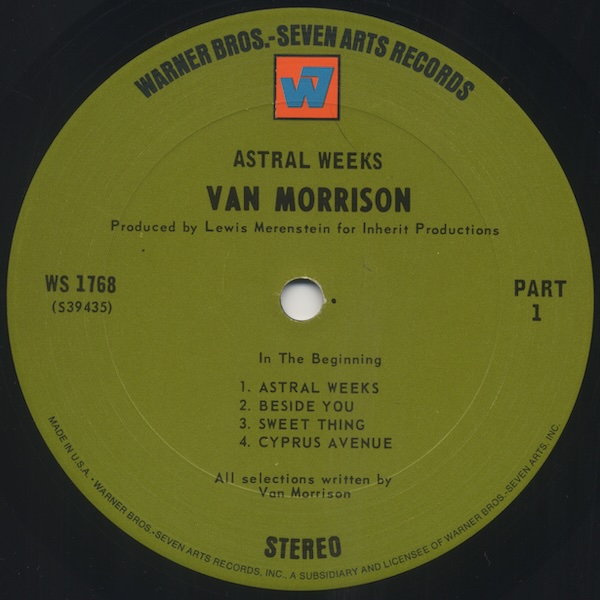
Astral Weeks / Van Morrison (Warner Bros.-Seven Arts WS-1768) Label Side-A
このアルバムは、過去に様々なフォーマットで数えきれないほど再発されてきましたが、2015年にリリースされた Expanded Edition CD の「ボーナストラックの」音には驚かされました。
This album has been reissued countless times in the past in a variety of formats, but the sound of “bonus tracks” on the Expanded Edition CD released in 2015 was really astounding.
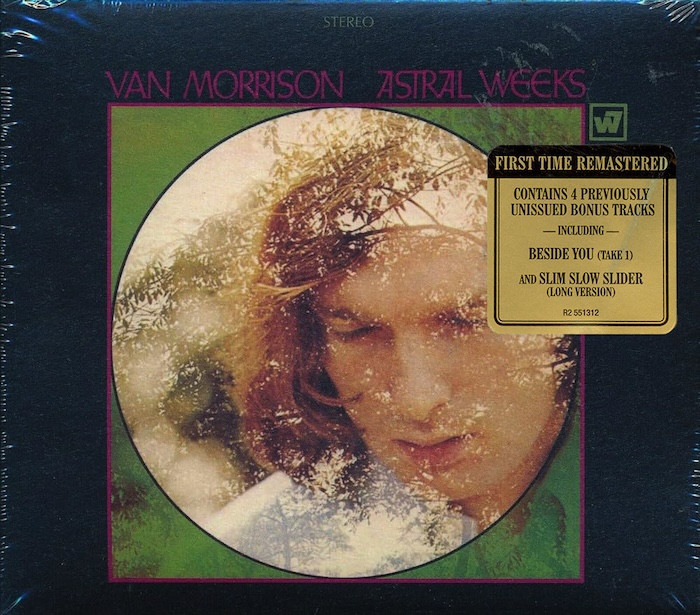
Astral Weeks / Van Morrison (Warner Bros. Records R2 551312, 2015)
特に、ラスト2曲の “Madam George (Long Version)” と “Slim Slow Slider (Long Version)” は、オリジナル盤LP、過去のさまざまな CDリリース、ディジタルリリースなど、どれと比べても(全く同一テイクのロングバージョンなのに)音がびっくりするほどナチュラルで、ギター、ベース、ヴィブラフォン、いずれも生々しい感触の音となっており(あくまで個人の感想です)、初めて聴いた時には涙を流すほどでした。
In particular, the last two tracks — “Madam George (Long Version)” and “Slim Slow Slider (Long Version)” — sound surprisingly natural compared to the original LP, various past CD reissues and digital releases, even though they are just long versions of the exact same takes. The sounds of guitars, bass and vibraphone all have a raw feel (just my personal opinion). The first time I heard it, it brought tears to my eyes.
1968年当時のエンジニアは Brooks Arthur 氏、録音は Arthur 氏の Century Sound Studios, NYC で行われました。そして 2015年版 CD のエンジニアは Bernie Grundman Mastering の Chris Bellman 氏です。
The engineer in the original 1968 sessions was Brooks Arthur, and the recording was done at Arthur’s Century Sound Studios, NYC. The engineer for the 2015 Expanded Edition CD is Chris Bellman of Bernie Grundman Mastering.
もし、ボーナストラックの音が、Chris Bellman 氏マスタリング由来とするならば、オリジナル盤に相当するトラック1〜8の音の感触も、ボーナストラックに準じたものになっていたはずです。
If the bonus tracks were mastered by Chriss Bellman, then the sound feel of tracks 1-8 (which correspond to the original album) would have been similar to the bonus tracks.
これはいったいどういうことでしょう。
What does this mean?
そこで、こう考えてみました。トラック1〜8は、Brooks Arthur 氏により録音されたマルチトラックマスターテープから Arthur 氏自身によって LP 用にミックスダウンし制作されたマスターテープ(この時 EQ など音作りされたはず)由来で、これを Bellman 氏が(オリジナルLPを尊重した上で)リマスタリングした音源。
So, here’s what I came up with. Tracks 1-8 are derived from a multi-track master tape recorded by Brooks Arthur, mixed down for the LP by Mr. Arthur himself (at that time, EQ, etc. must have been done). Then Mr. Bellman remastered it with respect to the original LP.
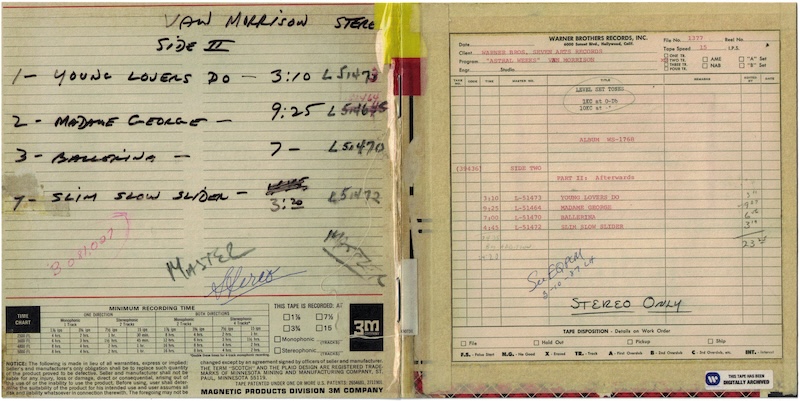
from the booklet of “Astral Weeks (Expanded Edition)” (Warner Bros. R2-551312)
Expanded Edition ブックレットに掲載された、B面用マスターテープのボックス写真
一方、ボーナストラック9〜12は、(LP用マスターよりさらに1世代若い)マルチトラックマスターテープから、新たに Bellman 氏がミックスダウンしマスタリングしたもの。あるいは、フェードアウトや短縮などエディットされる前の、LP マスターを制作する直前の(EQ がかけられていない)2chステレオマスターテープを使って収録されたもの。
Bonus tracks 9-12, on the other hand, are newly mixed down and mastered by Mr. Bellman from multi-track master tapes (one generation younger than the LP master). Alternatively, 2-channel “not EQ’d” stereo master tapes existed, just before the LP masters were produced, without any fade-outs, shortening, or other edits, then Mr. Bellman used this tape.
そう考えると、両者の音の佇まいの違いが理解できる気がします。
In this light, I think I understand the difference in sound feel and appearance between these two.
つまり、(リイシューにあたり Bellman 氏が積極的に音作りをしていない限り)ボーナストラックの音の感触がマルチトラックマスターテープの音の感触に近く、オリジナル盤や再発盤の通常のトラックの音は、当時 Brooks Arthur 氏が LP カッティングマスターテープ制作時にEQなどで施した音の感触、と考えることが可能です。
And in other words, the sound of the bonus tracks is close to the sound of the multi-track master tape (unless Mr. Bellman aggressively EQ’d the sound for the reissue), while the sound of the regular tracks on the original LP and reissues can be thought of as the sound that Mr. Brooks Arthur applied EQs, etc. to the master tape when he made the LP cutting master tape at the time.
Brooks Arthur 氏が逝去したいま、上記の推測が合っているのか、間違っているのか、は、正確に調べようがないかもしれませんが、LP カッティング用マスターテープを制作する際に、ある程度の音作りをしていたであろうことは想像できますし、それがこの音の違いとなって現れていると考えられる気がします。
Now that Mr. Brooks Arthur has passed away, there may be no way to find out if the above guess is correct or not, but it may be safe to say that Mr. Arthur utilized EQs, comps, etc. to create the sound of the LP cutting master, and this would be the reason for the difference in the sound between Tracks 1-8 and 9-12.
24.3.2 45rpm masters on James Brown “The Singles” (Hip-o-Select)
Alan Leeds + Harry Weinger の黄金ペアによる完璧なクロニクル、「The Singles, Volume One: The Federal Years 1956-1960」(2006)〜「The Singles, Volume 11: 1979-1981」(2011)まで、足掛け6年で完結した James Brown 全シングル音源のコンピレーション CD シリーズ(合計22CD)は、発売される度に楽しみに購入し、隅々まで聴き込み、唸らされました。
The perfect chronicle by the golden pair of Alan Leeds and Harry Weinger — the compilation CD series of all James Brown singles (22 CDs in total), from “The Singles, Volume One: The Federal Years 1956-1960” (2006) to “The Singles, Volume 11: 1979-1981” (2011). It took six years to complete, and it had been a joy to buy each time it was released, and I listened to them in details, and was amazed by them.
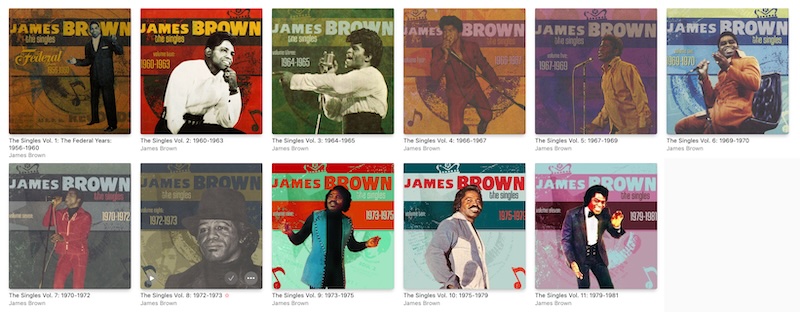
The Singles, Vols. 1-11 / James Brown (Hip-o-Select, 2006-2011)
ライナーノーツを含め、尊師の聖典の一部
このシリーズが特に素晴らしいのは、ライナーに「All songs mastered from the original (mono) single masters」と明記されている通り、本当に当時 Federal / King / Smash / Polydor / … からリリースされていた45回転盤シングル盤をカッティングするために使われたマスターテープを使って、CD 復刻されていることです。
What makes this series particularly impressive is that, as the liner-notes clearly state, “All songs mastered from the original (mono) single masters”, these CD reissues are indeed based on the master tapes used to cut the 45 rpm singles released at the time by Federal / King / Smash / Polydor / etc.
よって、LP 用マスターの音とも違う、後年の各種コンピレーションで聴かれる(恐れ多いほど素晴らしい内容・品質・音質の、恐らくはマルチトラックマスターから再ミックスされたであろう)最新リマスターの音とも違う、当時のシングル盤(のラッカー盤をカッティングする直前のマスター)の音がそのままストレートに詰め込まれており、当時の多くのリスナーが耳にしていたであろう音を追体験できるのです。
Thus, unlike the sound of the LP masters, and unlike the sound of the latest remasters (with astonishingly excellent content, product quality and sound quality, presumably remixed from multi-track masters) heard on various compilations in later years, this CD series contains the sound of the 45 rpm single records of the time (more precisely, the sound of the 45 rpm single masters) — you can relive the sound that many listeners would have heard at that time.
例えば、ファンクの萌芽として名高い名曲「Out of Sight」に先駆けること2年、1962年にシングルリリースされた、気絶しそうなアップテンポの(間違いなくのちのファンクの原点の1つとなった)16ビートナンバー「I’ve Got Money」。
For example, here’s “I’ve Got Money”, a swoon-inducing up-tempo 16-beat number (arguably one of the originators of later Funk), released as a single in 1962, two years before the famous “Out of Sight” (a classic that would became the germ of funk).
「The Singles Vol. 2」に収録された、低域と中域を持ち上げコンプをかけた、1962年当時のシングルマスターの音。
Below is the sound of the single master from 1962, included on “The Singles Vol.2”, with the low and mid frequencies lifted and compressed.
1966年リリースのLP「I Got You (I Feel Good)」のCDリイシューに収録された、リヴァーブを足し、(いかにも1960年代中盤らしい)低域を更に持ち上げ高域を大幅に下げた(まるでシングル向けマスターのような音の)、当時のLPマスターの音。
Next is the sound of the CD reissue of the LP “I Got You (I Feel Good)” released in 1966, with reverb added (typical of the mid-1960s), the low frequencies further lifted and the high frequencies lowered significantly, as if it were for 45 rpm masters.
1984年(LP)/1989年(CD)リリースのコンピレーション「Roots of a Revolution」に収録された、マルチトラックテープからリマスターされたと思われる、上の2音源よりはナチュラルな感触だけどリヴァーブが多めにかかった、ステレオ音源。
Then next is a stereo version from the 1984 (LP) / 1989 (CD) compilation “Roots of a Revolution”, which seems to have been remastered and remixed from a multitrack master tape, and has a more natural feel than the above two recordings, but with natural reverb.
それぞれあまりにも違う音の印象です。「Roots of a Revolution」収録のものだけ、コンプ適用が控えめなせいなのか、収録レベルが低くなっていますが、音圧を揃えて再生してもなお、それぞれの「音作りの跡」の違いが如実に聴き取れます。
The sound impression of each track is so different from the other. The sound level of the one from “Roots of a Revolution” is lower than the other two, perhaps due to the modest application of compressors, but even when played back at the same sound pressure level, the differences in the “traces of sound production” can be clearly heard.
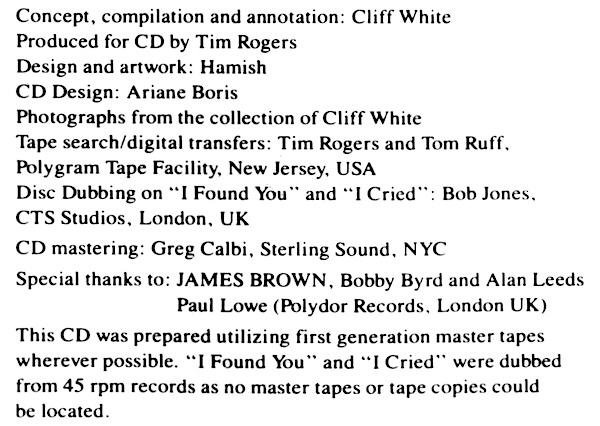
source: booklet of “Roots of a Revolution” (Polydor 817 304-2, 1989), p.3.
45回転盤からトランスファーされた “I Found You” と “I Cried” を除き、収録全曲が「1stジェネレーションマスターを利用」とある
1965年に大ヒットを記録した当時のシグネチャーソングの1つ、「Papa’s Got A Brand New Bag」。
One of his signature songs of the time, “Papa’s Got A Brand New Bag”, a big hit in 1965.
1991年グラミー賞最優秀アルバムノート(ライナーノーツ)を受賞した同年の大名盤4CDボックスセット「Star Time」の CD1 最後に収録された「Papa’s Got A Brand New Bag, Pts. 1, 2 & 3」の音には、リリース当時度肝を抜かされましたし、かなり話題にもなりました。
The sound of “Papa’s Got A Brand New Bag, Pts. 1, 2 & 3”, the last track on CD1 of the 1991 classic 4CD box set “Star Time”, which won the 1991 Grammy Award for Best Album Notes, was quite astonishing when it was released, and it was also the talk of the town.
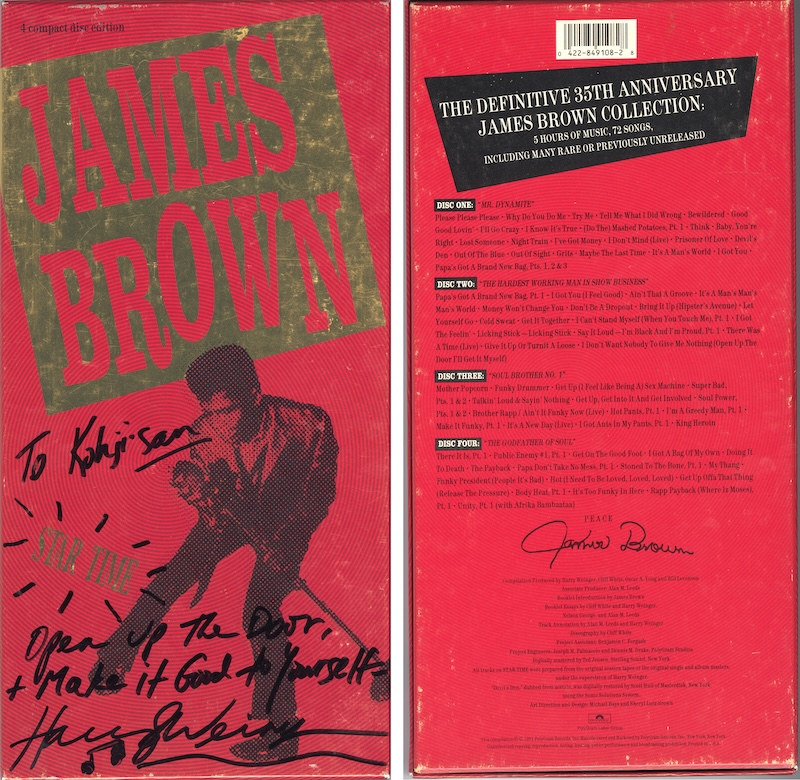
Star Time / James Brown (Polydor 849 108-2, 1991)
問答無用の大名盤、グラミー賞を受賞した4CDボックスセット
2017年5月、佐藤潔 さんと一緒に 新宿で会食した 際、Harry Weinger さんにサインしてもらいました
シングルやLPなどで幾度となくリリースされてきた有名なバージョンと比べ、ピッチが半音低く、またいっさいリヴァーブがかかっていない、ドライで生々しい音だったのです。しかも、ノーカットで6分58秒にも及ぶコンプリートバージョンです。
Compared to the well-known version that has been released so many times on singles, LPs and compliations, the pitch of the uncut complete version of 6 minutes and 58 seconds was a semitone lower, and the sound was dry and raw, with no reverb at all.
つまり、元々のセッションで録音された際には、こんな遅いピッチとドライな音で記録されていたものを、リリースに際して大胆にテンポアップし(半音ピッチを上げ)、さらにリヴァーブとコンプを多めにかけ、後半1/3を割愛したものがシングルマスターとなったのです。
In other words, what was recorded at such a slow pitch and dry sound when it was originally recorded at the session was boldly increased in tempo (raised a semitone in pitch) for release, with more reverb and compression applied, and the last 1/3 of the track was omitted, resulting in a 45 rpm single master.
そして、このシングルマスターの音が底本となり、その後の LP やコンピレーションに収録され続けていくことになります。
Then the sound of this single master would become the source material and continue to be included on subsequent LPs and compilations.
以下のものは、1996年リリースの名作コンピレーション2CD「Foundations of Funk: A Brand New Bag: 1964-1969」収録のバージョンで、シングルA/B面をノーカットでつないだものとなっており、当時のシングル盤用カッティングマスターテープからトランスファーされたものでしょう。我々が長年親しんできた音がそこにはあります。
The following is a version of the classic compilation 2CD “Foundations of Funk: A Brand New Bag: 1964-1969” released in 1996, which is an uncut version of the A/B sides of the 45 rpm single release. It must have been transferred from the single cutting master tape of that time — the sound we have known and loved for many years.
オリジナルマスターテープからストレートトランスファーされたと思われる音は、結果として、現時点でも(YouTube への野良アップロードを除き)上述の「Star Time」でしか聴くことができません。当該コンピレーションはストリーミング配信されていないのが残念です。
The sound of the uncut / unedited version with original pitch, which appears to have been transferred straight from the original master tape, is consequently still only available at this time on the “Star Time” compilation mentioned above (except unofficial YouTube uploads). I regret that the compilation in question is not yet available for streaming.
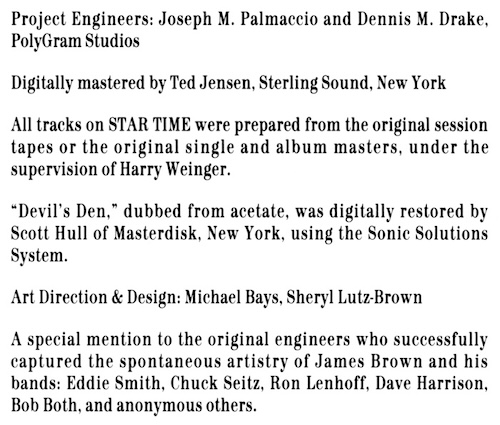
source: booklet of “Star Time” (Polydor 849 108-2, 1991), p.63.
アセテートから復刻された “Devil’s Den” を除き、収録全曲が「オリジナルセッションテープ、またはシングルマスターやアルバムマスターから収録」とある
1966年、インストのみという契約で Mercury 傘下の Smash レーベルから出された時期、シングルリリースされた「New Breed (The Boo-Ga-Loo)」。
“New Breed (The Boo-Ga-Loo)” was released as a single in 1966, during the period when it was put out on the Mercury-owned Smash label under an instrumental-only contract.
「The Singles Vol. 4」に収録された、意外とドライだけどやっぱり1966年当時っぽい、カマボコ波形のシングルマスターの音。
Here’s the sound of the single master heard on “The Singles Vol.4”, which is surprisingly dry but still sounds like 1966.
シングルバージョンに比べるとふくよかな(エッジの甘い)音で、かつリヴァーブが大量にかけられた、同名タイトルの LP(Smash MGS-27080 / SRS-67080)に収録されたバージョンの音(ストリーミング未収録)。
Next is the sound of the version on the LP of the same title (Smash MGS-27080 / SRS-67080), which has a fuller sound than the single version and is heavily reverbed (this version is not available for streaming yet).
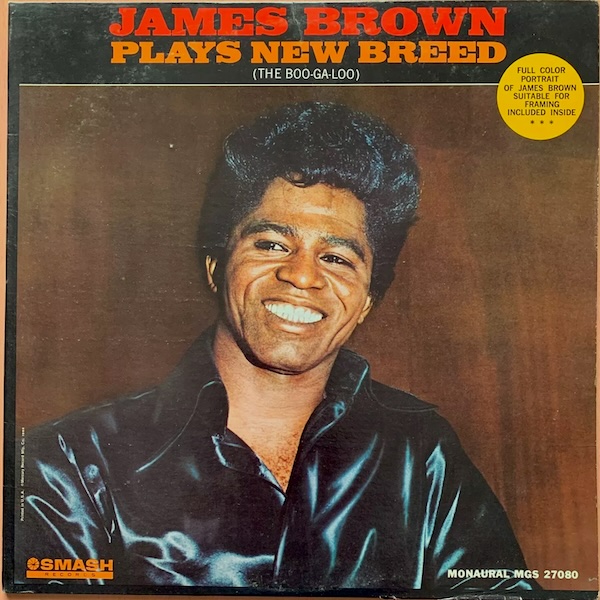
1993年、Alan Leeds と Harry Weinger のコンビによって編纂された、インスト集 2CD「Soul Pride: The Instrumentals」に収録された、マルチトラックマスターテープ由来のナチュラルなステレオ音源。
Then here is the natural stereo sound derived from multi-track master tapes, included in the 2CD instrumental compilation “Soul Pride: The Instrumentals”, compiled by Alan Leeds and Harry Weinger in 1993.
これらも、笑ってしまうほど音の印象が違います。
These, too, are laughably different in sound impression.

source: booklet of “Soul Pride: The Instrumentals” (Polydor 314 517 845-2, 1993)
オリジナル3トラックまたは4トラックマスターからリミックスされた楽曲名、“New Breed” も書かれている
1968年、ファンクの一里塚として刻み込まれた大名曲「Give It Up Or Turnit A Loose」のオリジナルバージョン。
The original version of the masterpiece “Give It Up Or Turnit A Loose”, which was etched as a milestone in Funk, in 1968.
「The Singles Vol. 5」に収録された、1968年当時のシングルマスターの音。
Below is the sound of the single master from 1968, included in “The Singles Vol.5”.
1970年リリースのLP「It’s A New Day — So Let A Man Come In」の再発CDに収録された、高域を持ち上げたような(そしてほんの少しピッチが遅い)LP マスターの音。
Next is the sound of the LP master on the reissue CD of the 1970 LP “It’s A New Day — So Let A Man Come In”, which seems to have lifted the high frequencies (and is just a little slower in pitch).
1991年4CDボックスセット「Star Time」収録の(マスターテープ由来と思われる比較的ドライな)音を引き継いで、低域を強調した、大名盤コンピレーション「Foundations of Funk: A Brand New Bag: 1964-1969」収録のロングバージョン。
Next is the long version on the great compilation “Foundations of Funk: A Brand New Bag: 1964-1969”, presumably inheriting the relatively dry sound of the version on the 1991 4CD box set “Star Time” (derived from the original master tape), but the low frequencies a bit boosted.
これもまたそれぞれに音の印象が違います。
These also have different sound impressions.
1969年、「Mother Popcorn」と並び、JBファンクの当時の完成形を体現した「It’s A New Day」。
In 1969, “It’s A New Day” embodied the perfection of JB Funk at the time, along with another killer “Mother Popcorn”.
「The Singles Vol. 6」に収録された、1969年当時の若干カマボコ帯域のシングルマスターの音。
Here’s the sound of the single master from “The Singles Vol. 6” with a slightly narrow bandwidth from 1969.
1970年リリースのLP「It’s A New Day — So Let A Man Come In」の再発CDに収録された、シングルに比べて高域の抑制は減っているがやはり中域が厚い(そしてほんの少しピッチが遅い)、LPマスターの音。
Next is the sound of the LP master on the reissue CD of the 1970 LP “It’s A New Day — So Let A Man Come In”, less attenuated in the highs but still thicker in the mids (and just a little slower in pitch) than the single.
マスターテープからストレートトランスファーっぽい、ドライだけど若干低域が薄い印象がある 1986年版「In The Jungle Groove」の音。なお、ストリーミング未収録ですが、2003年版リマスターの「In The Jungle Groove」では、中域の力強さが増し(しかし若干コンブ気味)、カットされた冒頭の会話が復元されています。
Next is the longer version from the compilation album “In The Jungle Groove” (1986), which seems to be a straight transfer from the master tape, with a dry but slightly thin in low-frequency range. Please note that, although not available for streaming, the 2003 remastered version of the album “In The Jungle Groove” has more mid-range strength (but slightly compressed “toothpaste-ish” sound), and the cut beginning of the chat has been restored.
2003年版「In The Jungle Groove」収録バージョンの音の雛形であろう、1996年「Foundations of Funk: A Brand New Bag: 1964-1969」収録の、終わりがフェードアウトせず笑い声まで入っているロングバージョンの音。
Below may have served as a template of the sound from the 2003 remastered version of “In The Jungle Groove” — the version from the “Foundations of Funk: A Brand New Bag: 1964-1969” (1996), also a long version and does not fade out (even including laughter) at the end.
これもまた、面白いように音の印象が異なります。
These also give an interestingly different impression of sound.
例をあげるときりがないのですが、このように、時代ごとにシングル向けや LP 向けそれぞれに、セッションで録音されたマスターテープの音をイコライジングしコンプレッションをかけ、当時の音を作っていた、その一端が垣間見える、非常に興味深いサンプルとなっています。
There are too many examples to list, but these are very interesting samples that give a glimpse of how the sound of the time was created for singles and LPs, respectively, by equalizing and compressing the sound of the master tapes recorded at each session.
それだけ、1960年代〜1970年代のポピュラー音楽(R&B、ソウル、ファンク系などは特に激しかったのかもしれませんが)では、RIAA 録音特性でカッティングする前段で、当時のトレンドだったりエンジニアの試行錯誤だったり(時には気まぐれだったり?)、さまざまな音に仕立てたカッティング用マスターを制作していたことになります。
That is why popular music from the 1960s to the 1970s (R&B, Soul, Funk, etc., may have been particularly intense, though) was produced in a variety of ways, depending on the trends of the time, the engineer’s trial and error (or sometimes whim?), or various other factors. In this way, the sound of the cutting master tapes were created. This was all done before the lacquers cut with the RIAA recording characteristics.
24.3.3 The Beatles’ U.S. Capitol Releases
実は、私が人生で初めて購入した(親にねだって買ってもらった)ビートルズのレコードは、1984年のこと、国旗帯の「The Beatles’ Second Album」(EAS-80563) でした。ジャケットにたくさん写真が写っているから、というそれだけの理由でした。
This is a nostalgic story, way back in 1984 (when I was fourteen) — the very first Beatles record I ever bought in my life (more precisely, I begged my parents to buy it for me) was “The Beatles’ Second Album” (EAS-80563), with a “Flag” OBI. The only reason I picked it up was because it had a lot of pictures of the members on the cover.
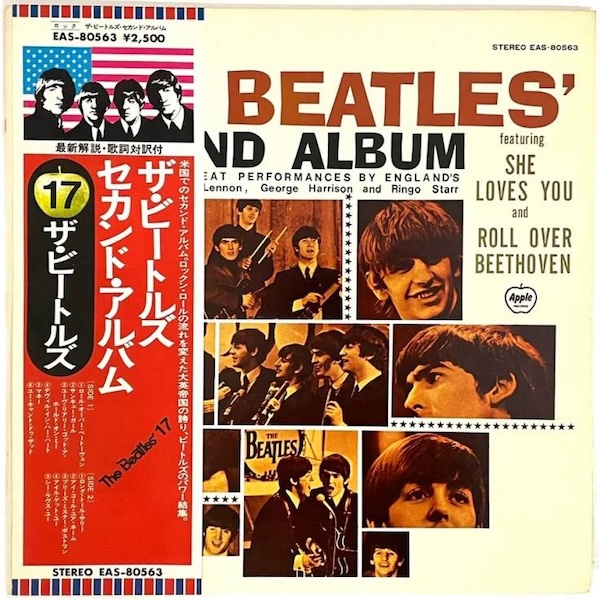
The Beatles’ Second Album (Capitol / Apple / Toshiba EMI EAS-80563)
後年、英国盤の「With The Beatles」を聴いた時、あまりの音の違いにびっくりした記憶があります。つまり、この東芝EMI盤は、U.S. Capitol のマスターテープのコピーから制作されたもので、のちに入手したUS盤(Capitol ST-2080)に準ずる音になっていたのです。
I remember being surprised at how different the sound was when I heard the U.K. version of “With The Beatles” in later years. In other words, this Toshiba-EMI edition was produced from a copy of the U.S. Capitol master tape, and sounded similar to the U.S. release (Capitol ST-2080) that I later acquired.
この当時の US Capitol 盤の音は、2004年にリリースされたボックスセット「The Capitol Albums」(Capitol/Apple CDP 7243 8 66878 2 1) で聴くことができます。1960年代当時に Capitol が使ったカッティング用マスターテープ(あるいはカッティング用マスターテープにコピーする前の US マスターテープ)由来の音です。
The sound of this period U.S. Capitol albums can be heard on the box set “The Capitol Albums” (Capitol/Apple CDP 7243 8 66878 2 1), released in 2004. The sound is derived from the cutting master tapes used by Capitol in the 1960s (or the U.S. master tapes before they were copied into the cutting master tapes).
最も違いが分かりやすいのが、件の「The Beatles’ Second Album」の音で、英国から送られてきたマスターテープのコピーに対し、大胆にイコライズとコンプを追加でかけ、さらにリヴァーブを多めにかけることで、元々のドライな音を大胆に改変してしまっています。擬似ステレオ(Duophonic)楽曲のお風呂場で聴いているかのような音も特徴的です。
The most obvious difference is in the sound of “The Beatles’ Second Album”, where the original dry sound has been drastically altered by applying additional equalization, compression, and an excessive reverb to a copy of the master tape sent from the UK. The sound of the fake stereo (DUOPHONIC) tracks is also distinctive, as if you were listening to them in a bathhouse.
とはいえ、私個人にとっては、若き日の記憶と共にある、思い出深い音ではありますが。
However, for me personally, it has been a memorable sound that is with the memories of my youth.
この音の改変は、かの有名な Dave Dexter, Jr. 氏の意向によるものと言われ、当時 George Martin や Beatles 本人たちからも不評を買ったと言われているほか、評論家の Dave Marsh 氏には「正真正銘の愚行 (genuine stupidity)」とまで酷評される始末でした。
It is known that this sound modification was made at the behest of the famous Dave Dexter, Jr., and was unpopular with George Martin and the Beatles themselves, and was even criticized by the critic Dave Marsh, who called it “genuine stupidity”
Dave Dexter Jr., the Capitol Records executive who assembled the album, despised rock ’n’ roll as a whole, believing it inferior to what he called “legimate” music. It’s indisputable that the group came to hate the idea of Dexter’s butchery.
このアルバムを制作した Capitol Records の重役、Dave Dexter, Jr. は、ロックンロール全体を軽蔑し、彼が「正統派」と呼ぶ音楽より劣っていると考えていた。Dexter が行ったズタズタの解体(注:ここでの「butchery」は、当然ブッチャーアルバムを意識した表現でしょう)をグループが憎むようになったのは、紛れもない事実だ。
“The Beatles' Second Album (Rock of Ages)”, p.1, Dave Marsh, Rodale Books, 2007さらに Marsh 氏は、Dexter 氏が主導したと言われる過剰なリヴァーブやイコライズを「Dexterize」という動詞で表現しています。
Furthermore, Mr. Marsh uses the verb “Dexterize” to describe the excessive reverb and equalization that Dexter is said to have initiated.
Marsh uses the verb “Dexterize” to refer to the unwanted addition of reverb and equalization, which makes high and low frequencies proportional, and adds that “to almost everyone, the British Beatles records sound crisper, the rhythm section has more punch, the guitars ring with much more clarity.”
Marsh 氏は、不要なリヴァーブやイコライズを加えて、高域と低域を共に強調したことを「Dexterize」という動詞で表現し、さらに「ほとんどの人にとって、ビートルズの英国盤はより鮮明な音で、リズムセクションはよりパンチがあり、ギターははるかに明瞭に鳴っている」と付け加えている。
Though what would one expect, Marsh asks, from someone who boasted of releasing albums like “German Beer-Drinking Music” and “Songs for Sunbathing in Switzerland”?”
一方で Marsh はこのように問いかける、「『ドイツのビアフェストでかかる音楽』や『スイスで日光浴をする時の歌』のような(音のするビートルズの)アルバムをリリースした、と自慢していた人物に対して、一体何を期待せよというのだろう?」
“Got a Hold on Me”, David Kirby, The New York Times, 2007一方、Dave Dexter, Jr. 氏の自伝「Playback」(1976) では、ビートルズの4人が Capitol の作り出した音に満足していた、と書かれていたりもしていて、不思議です。
On the other hand, strangely enough, in Dave Dexter, Jr.’s autobiography “Playback” (1976), he wrote that the four Beatles were satisfied with the sound produced by Capitol.
His Mersey accent was difficult to comprehend. We talked for a moment or so and all I recall him say was that he and his mates were delighted with the equalization improvements Capitol’s engineers had devised for their first record. In running the original Beatles tape through our system as an American master was dubbed, we had extended the high frequencies and added slight reverberation to give the single a “hotter” sound.
彼(Paul)のマージー訛りは聞き取りにくかった。しばらくの間、彼と話したが、私が覚えているのは、Paul とその仲間が、Capitol のエンジニアが彼らの最初のレコードのために考案したイコライゼーションによる改良・改善を喜んでいたということだけだった。(英国から送られてきた)オリジナルのビートルズのテープを再生しアメリカマスターとする際、高域を伸ばし、多少リヴァーブを足すことで、シングル(“I Want to Hold Your Hand”)は「よりホットな」音となった。
The Beatles had noticed the improvement and were pleased.
ビートルズはこの改良に気づき、そして喜んでいた。
“Playback”, p.178, Dave Dexter, Jr., Billboard Publications, 1976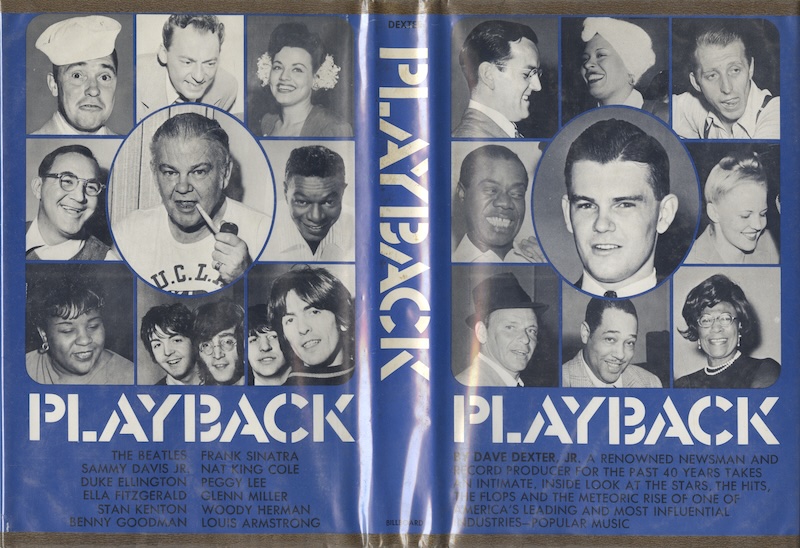
“Playback”, Dave Dexter, Jr., Billboard Publishing, 1976.
当時の全ての Capitol のレコードが、このような音にされたわけではありませんでした。実際、Beatles の他の米国盤アルバムでのイコライズやリヴァーブ付加は、いかにも当時の Capitol っぽい範囲内に収められているように聴こえます(とはいえ英国マスターとはかなり音が違いますが)。
Not all Capitol albums of the time were made to sound like this. In fact, the equalization and reverb added to the Beatles’ other U.S. albums seem to have been kept within the Capitol-esque bounds of the time (although they still sound quite different from the U.K. masters).
そして、同時期の他アーティストの Capitol アルバムでも、ここまで過剰な音の変更は多くはありませんでした。ですから、「The Beatles’ Second Album」が特に顕著だった、ということなのでしょう。
And there were not many Capitol albums by other artists of the same period that had such excessive sound alterations. So, “The Beatles’ Second Album” was one of the particularly remarkable exceptions.
いずれにせよ、このような音の改変は、ディスク録音イコライザより前段の、カッティング用マスターテープの時点で付加され、いじられていた音であることは間違いありません。ディスク録音イコライザを通過する前の米国マスターテープ、それ由来の CD でも同系統の音なのですから。
In any case, there is no doubt that these sound modifications were added and tinkered with at the time of the master tapes for cutting, which is prior to the actual cutting with disc recording equalizers. In fact, the sound of CDs reissued from U.S. master tapes (before passing through the disc recording equalizer) is of the same type.
そういう意味で、ビートルズとビーチボーイズの音源を2曲ずつ含む当時のコンピレーション「Chart Busters Volume 4」(Capitol ST-2094, 1964) 、なかなか入手する機会に恵まれずにいますが、アルバム収録の各曲がどのような音になっているのか、いつか聴いてみたいものです。
I have not had a chance to obtain the compilation LP “Chart Busters Volume 4” (Capitol ST-2094, 1964), which includes two songs each by the Beatles and the Beach Boys. In that sense, I would like to hear how each song on the album sounds like.
本稿前半で述べた通り、当時の Capitol はご自慢のエコーチェンバーを縦横無尽に活用していました。特に1960年代に入ってからは、当時のトレンドなのか、リヴァーブ追加に加えて EQ で音をいじることも多くありました。
As mentioned in the first half of this article, Capitol at that time was making full use of its famous echo chamber. Especially in the 1960s, Capitol often used EQ in addition to reverb, which may have been a trend at that time.
Frank Sinatra の世紀の名盤「Songs For Young Lovers」(1954) ですら、1962年に12インチLP化された際、リヴァーブと EQ をかけ、せっかくのコンセプトアルバム的な曲順も改悪されてしまいました。
Even Frank Sinatra’s classic masterpiece of the century, “Songs For Young Lovers” (1954), was remastered with reverbs and EQs when it was reissued as a 12-inch LP in 1962. Song order of this “concept album” was also altered.
のちに曲順は元に戻されたものの、リヴァーブが付加された音源がCD時代に入っても長らくマスターとして使われていました(最近はオリジナルマスター由来に変更されています)。
Although the song order was later restored, the reverbed sound source remained the master for a long time, even into the CD era (recently it has been replaced by the original master without reverbs).
24.4 The summary of what I got this time / 自分なりのまとめ
本当は、セクション 24.3.4 として、Frank Zappa の「The Hot Rats Sessions」のことも書こうと思っていたのですが、これ以上長くするのも脱線しすぎるのも良くないと思い、割愛しました(笑)
I was actually going to write about Frank Zappa’s “The Hot Rats Sessions” as Section 24.3.4, but I didn’t want to make this article any longer or digress too far 🙂
ともあれ、今回の Pt.24 では、過去に調べ学んできたことを踏まえ、録音・再生時のシグナルチェーン(信号経路)について、改めて概観してきました。
Anyway, in this Pt. 24, I have reviewed the signal chain (signal path) during recording and playback, based on what I have studied and learned in the past.
さまざまな特徴や特性を持つ機器で構成されたシグナルチェーンを介し、またエンジニアによる職人技の結果として、最終的なメディアに音情報が記録される。その際、録音機器や記録メディアの音響的・電気的・物理的特性を活かし、同時に幾多の制約事項に対抗するために、数えきれないほどの機器が開発されてきた。また一方で、エンジニアやプロデューサが、これらの機器を最大限活用し、狙った音作りを行う、その手段としても活躍してきた。
Sound information is recorded on final media, through the signal chain of many equipment with various features and characteristics and as a result of craftsmanship by engineers. In this process, countless devices have been developed to take advantage of acoustic / electrical / physical characteristics of the recording equipment and recording media, and at the same time to overcome the numerous limitations. Also, these devices have also served as a means for engineers and producers to make maximum use of these devices to create their desired sound.
…という、至極当たり前のことを、改めて実感することができました。
… I was able to reaffirm what is blissfully obvious like noted above.
さてさて、今回の内容をざっくりまとめると、こんな感じでしょうか。
…so, the rough summary of my understanding in this Pt.24 article would be something like this:
ディスク録音再生EQカーブだけが、周波数応答特性を決定するものではない。録音時、ミキシング時、マスタリング時、カッティング時、再生時、それぞれの段階で、意図的に音にEQがかけられていたり、さまざまな音の変化が起こりうる。極論すれば、リスナーの聴覚や感性ですら受け取り方に差をもたらすと言える。
The disc recording and playback EQ curves are not the only factor that determine frequency response characteristics. Various sound changes can occur (or intentionally EQ’d) at each stage of recording, mixing, mastering, cutting, and even playback. In an extreme case, even the listener’s hearing and sensivity can make a difference in how the sound is perceived.
特にポピュラー音楽の分野では、スタジオによって、エンジニアによって、時代のトレンドによって、イコライザやコンプレッサ、リヴァーブなどさまざまな機器で音作りをすることが一般的である。そのような要因をあまり含まないクラシック音楽のレコードであればさておき、主観的な試聴判断で単純にフォノEQカーブだけの議論に落とし込むのは、特に米国のステレオLP以降に対しては、理にかなっていない。
Especially in the field of popular music, it has been common for different studios, different engineers, and different trends of the times to create sounds with various equipment such as program equalizers, compressors, reverbs, and so on. Aside from classical records that do not include many such factors, it is not reasonable to simplify the discussion to the selection of phono EQ curves, based on subjective listening judgements, especially for the U.S. stereo LPs.
当時制作されたLP用マスターテープからリイシューされた音源、マルチトラックマスターテープにまでさかのぼってリミックスされた音源、当時のシングル用マスターテープからリイシューされた音源などを聴き比べることで、ディスクカッティング直前の段階でさまざまな音作りがされていることが確認できる。
By comparing sound sources reissued from LP master tapes produced at the time, re-mixed sound sources that go back to multi-track master tapes, and sound sources reissued from single master tapes produced at the time, it is possible to confirm that various sound production processes were conducted at the stage just before disc cutting.
次回は、当連載最終回の予定です。どのようにまとめるかは、現在思案中です。
My next post will (probably) be the last part of the entire series article, although I’m still pondering what and how to write.
» 続き / Sequel: “Things I learned on Phono EQ curves, Pt.25” »








